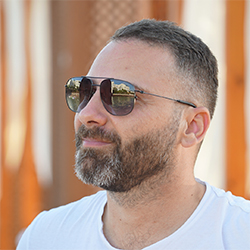20 Best Things to Do in Heraklion in 2025

Tourists have a lot of things to do and several places to visit in Heraklion in 2025. The Greek island of Crete’s capital, Heraklion, is home to various natural attractions, history and culture.
One is that the ancient ruins of the Minoan palace of Knossos are evidence of Europe’s earliest known civilization, which never ceased to fascinate visitors. History buffs must go to the Archaeological Museum of Heraklion, which houses items from Knossos. The Aegean Sea, the city and the Venetian Fortress of Koules, which guards the harbour, are all visible from Heraklion.
The old town’s winding streets are home to busy marketplaces, fountains and Venetian-era buildings. The Morosini Fountain in Lions Square is still a well-liked gathering spot. The Agora market offers Cretan specialties, herbs and spices for a flavour of local life.
Beautiful beaches offering sun, surf and leisure are nearby areas of natural beauty. The popularity of culinary tours has increased, exposing tourists to the diverse flavours of Cretan food.
Find below a list with the best things to do in Heraklion in 2025.
- Wander the Ancient Venetian Walls: Discover the Venetian Walls, which have protected Heraklion for centuries, to travel back in time. The walls provide both historical context and expansive city vistas.
- Do a day trip to Matala: Travel to Matala, a picturesque coastal community known for its beaches and caves. A unique experience is guaranteed by the harmonious blending of history and natural beauty.
- Discover Koules Fortress: Discover the former Venetian fortification that formerly protected the harbour of Heraklion. Tales of defence, sieges and marine supremacy are told in the fortress.
- Pay respects at Kazantzakis’ Tomb: Visit Nikos Kazantzakis’s grave, one of Greece’s most prominent authors. The simplicity of the mausoleum contrasts with the writer’s significant literary accomplishments.
- Experience the Historical Museum of Crete: Explore the rich history of Crete, which spans the early Cretan era to the current era. The museum’s extensive collection tells the story of the island’s dynamic past.
- Explore the Palace of Phaestos on a day trip: Visit Phaestos, another renowned Minoan palace that has sweeping views of the Messara plain. The ruins tell stories of ancient aristocracy and Cretan splendour.
- Visit the Heraklion Archaeological Museum: Discover the ancient Minoan culture of Crete by exploring an extraordinary collection of artefacts. The Archeological Museum in Heraklion is one of the most important museums for showing Minoan culture.
- Immerse in the art at El Greco Museum, Fodele: The El Greco Museum honours the works and life of the well-known painter El Greco. The museum is situated in painter’s birthplace, Fodele. The displays provide a window into El Greco’s artistic development and influence.
- Shop in the Old Town: Wander around the Old Town of Heraklion, where small stores offer regional handicrafts, treats and mementoes. The experience of shopping is enhanced by the old architecture and winding streets.
- Explore Lakkos’ Old Quarter: Explore Lakkos, a neighbourhood that historically housed artisans and labourers. The streets of the revitalised city are now lined with cafes, art galleries and relics from its colourful history.
1. Wander the Ancient Venetian Walls
One of the best things to do in Heraklion is to wander the Ancient Venetian Walls. The Ancient Venetian Walls of Crete, which are best visible near the city of Heraklion, serve as an impressive reminder of the island’s lengthy, varied past. The fortifications, built between the 15th and 17th centuries during the Venetian control of the island to ward off potential attackers, were architectural marvels of their time. The walls, which surround the historic area of the city and cover several kilometres, are punctured by bastions and distinguished by famous historical gates like the Lion Gate. The walls are crucial to the city’s defence and the formation of its urban development.
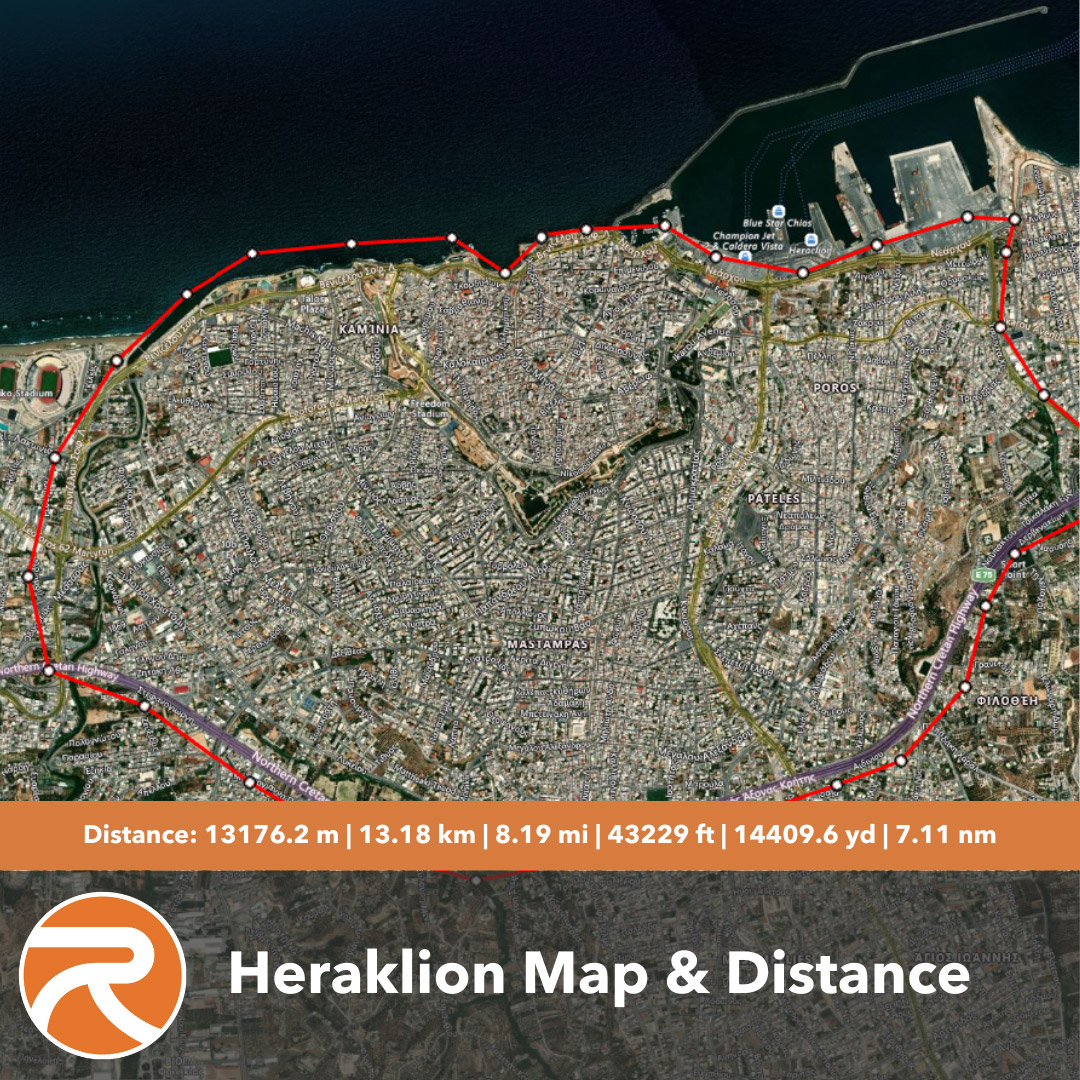
Stories of victories, sieges and tenacity have been told about the Ancient Venetian Walls guarding the city’s occupants. The fact that they are still standing today is a testament to the artistic talent and clever planning of the Venetian engineers and architects and to the stormy period in which they were built.
The number of visitors to the island of Crete has substantially increased since the 1970s. There is no specific count as to how many visitors the Ancient Walls have held in the past. Current reports regarding the yearly or monthly tourist count of the Ancient Venetian Walls are not established as well. The number of visitors is expected to vary from year to year depending on a number of variables, such as marketing initiatives, global events and travel patterns.
The old town of Heraklion is where the Ancient Venetian Walls lie. The three-kilometre-long wall has a base on the coastline side and is triangular in design. The entire walls have four primary entrances at different locations. One is located on the north side at the end of what is today’s August 25 Street known as The Gate of Molos, which united the town and the port. Another entrance is coined as The Gate of St. George or Lazaretto, which is located on the eastern side, close to the current Eleftherios Venizelos statue. It connects Candia with Eastern Crete and with the quarantine hospital (lazaretto).
The third entrance is called The Gate of Jesus or New Gate (Kenourgia Porta), which was constructed by the Venetians in 1587. It is located on the south side of the walls from which highways that go to the county’s southern provinces are visible. The fourth entrance is The Gate of Pantokratoras, located at the western extremity of the square Strata, serving as the town’s gateway to Western Crete.
Seven bastions or ramparts served as defences for the walls. They are substantial platforms that protrude from the walls to protect a broader area and efficiently support the neighbouring portions of the walls. The following are the names of the Ancient Venetian Walls’ seven bastions, namely; Sabionera (Sand) Bastion, Virouri Bastion, Kenourgia Porta Bastion, Martinengo Bastion, Bethlehem Bastion, Pantokratoras Bastion and St. Andrew Bastion.
The Ancient Venetian Walls are 4-5 kilometres from Heraklion Airport (Nikos Kazantzakis Airport). The drive from the airport to the walls normally takes between 10 and 15 minutes, depending on the flow of traffic.
Visitors of the Ancient Venetian Walls witness the spectacular bastions that punctuate the walls, each with a distinct design and function. There are Historical gates like the iconic Lion Gate, which has beautiful carvings and design, are among the walls’ top attractions. Tourists get panoramic views of Heraklion City and the Aegean Sea from several vantage points atop the walls.
Children explore the Ancient Venetian Walls in Heraklion, engaging with its bastions and imagining stories of knights and sieges. They are permitted to take part in any accessible interactive historical exhibits or seminars to make the experience more educational. They are expected to enjoy a fun pastime that allows them to see the city from a different vantage point by climbing up some of the walls. Some of the sections close to the walls frequently feature green spaces where kids are allowed to play and unwind after their exploration.
Tourists feel safe walking around Heraklion’s Venetian Walls, but, travel safety considerations including paying attention in busy areas must be followed. The 16th-century Venetian Walls require no entrance fee and anyone is allowed to roam and learn about the Venetian history of the island.
Nearby dining options enhance the experience. Erganos, 0.2 kilometers (0.1 miles) away, ranks among Heraklion’s top restaurants, serving Greek, Mediterranean, and local dishes. Oti Thes, also 0.2 kilometers away, specializes in barbecues and Mediterranean cuisine. Xalali Restaurant, located 0.3 kilometers (0.2 miles) from the walls, is renowned for its Greek and Mediterranean offerings, holding a Traveller’s Choice award in 2022.
Hotels near the walls provide comfortable accommodations. Legacy Gastro Suites, 0.2 kilometers away, offers modern amenities, including free WiFi, a restaurant, and secure parking, with a 9.2/10 rating on Trivago. Megaron Luxury Hotel, located 0.4 kilometers (0.25 miles) away, features spacious parking, free WiFi, and an on-site restaurant, boasting a 9.5/10 rating. Ibis Styles Heraklion Central, also 0.4 kilometers away, provides fully air-conditioned rooms, indoor parking, and other amenities, earning a 9.3/10 rating. These hotels ensure convenient access to the Venetian Walls and nearby attractions.
2. Do a day trip to Matala
People get the most out of their Heraklion getaway when they embark on a day trip to Matala. A little town called Matala is found on the island of Crete in Greece’s southernmost region with less than 100 people living there permanently. The village is well-known for its stunning beach and its caves, which were first inhabited by hippies in the 1960s and 1970s after being used as graves during the Roman era.
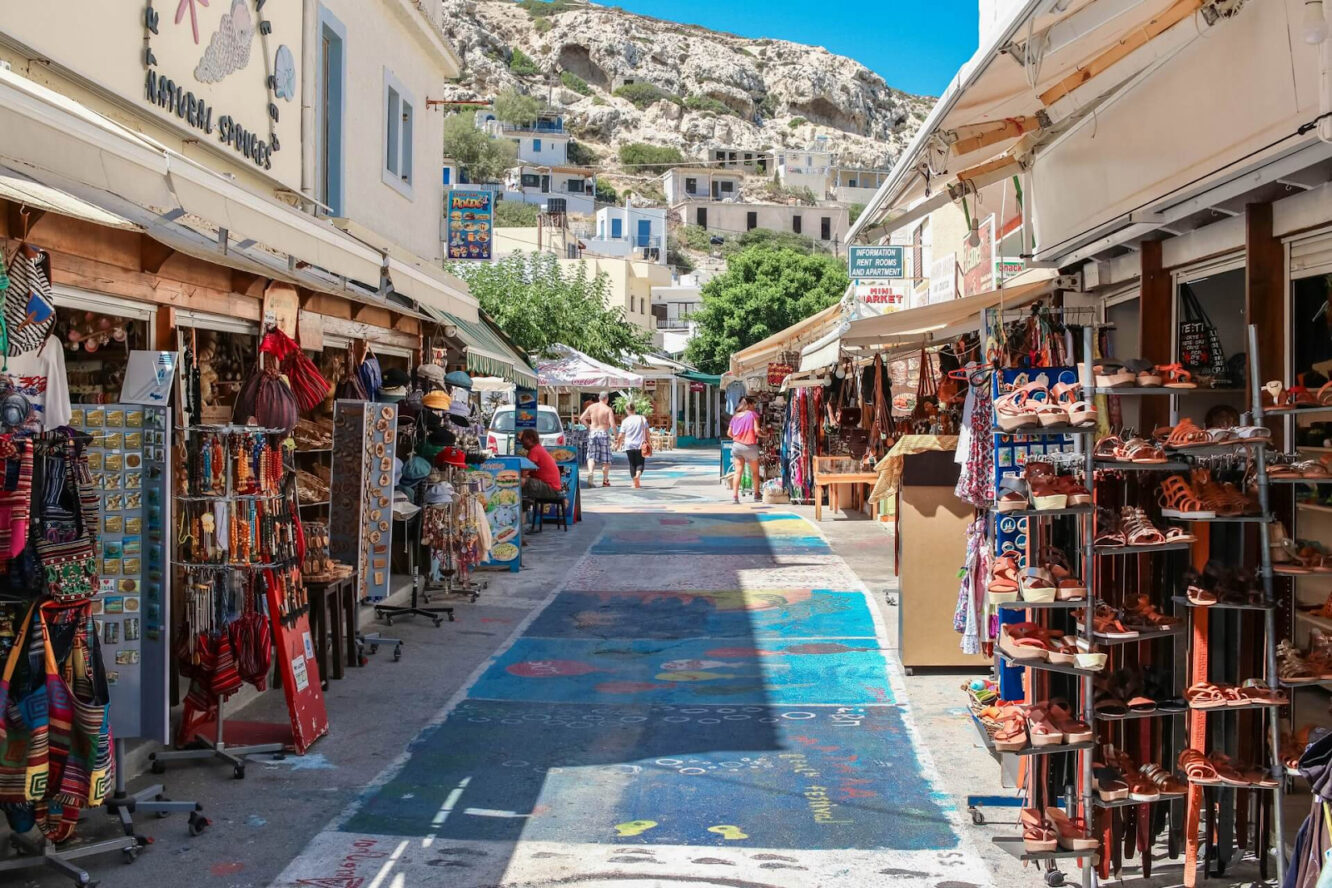
A day trip to Matala involves traveling to the village, spending several hours or the entire day exploring its attractions, and returning by nightfall. Matala’s daily visitor numbers remain undetermined, although the entire island of Crete has experienced significant tourism growth since the 1970s.
Matala lies on Crete’s southern coast, 70 kilometers (43 miles) from Heraklion International Airport. Travel between the airport and Matala takes 1 hour and 15–30 minutes, depending on traffic.
Matala features attractions including a historic fishing settlement by a coarse sand beach. The central square hosts a North African-style bazaar and a small church, alongside bookstores selling Cretan literature and displays of Matala’s hippie era. Nearby are Roman harbor ruins, a popular site. The Red Beach, once home to hippies, is a 30-minute walk from the village center.
Families enjoy Matala Beach, where children swim, build sandcastles, and explore the famous caves once inhabited by Romans and hippies. Shallow, calm waters ensure safety, and local ice cream shops and restaurants cater to young visitors. Family-friendly events and festivals further enhance the experience.
Matala is a secure destination, though visitors should stay informed about local conditions. Entry fees vary by attraction. The Matala Caves require a €4 fee, with reduced rates (€2) for EU citizens over 65 and free admission for EU citizens under 25 with ID. Matala Beach is free, though parking costs €2 per day. Red Beach has no entry fee, but visitors often bring their own essentials due to high prices for beach equipment.
Restaurants in Matala include Bistronomy Matala, George’s Yard, and Scala Fish Bar. Bistronomy Matala is rated the best on TripAdvisor, offering seafood and Greek cuisine with prices from €6.37 to €40.94. George’s Yard serves Mediterranean and Greek dishes, with meals ranging from €5.97 to €44.80. Scala Fish Bar ranks third, offering European and Greek options.
Nearby hotels include Fragiskos Hotel, Hotel Neos Matala, and Die Zwei Bruder Pension. Fragiskos Hotel, ranked first on TripAdvisor, offers 100 rooms, parking, and proximity (50 meters) to the town center and beach. Hotel Neos Matala, 500 meters from the beach, features a pool, garden, and breakfast patio. Die Zwei Bruder Pension, ranked second among inns, accommodates up to five guests and provides bicycle rentals, parking, and children’s activities.
3. Discover Koules Fortress
Another way to enjoy one’s Heraklion experience is to discover Koules Fortress. The Koules fortress, better known as the “Rocca al Mare”, is a famous Venetian-era castle that guards the entrance to Heraklion’s historic port. The huge fortress, made of thick stone walls, was created to keep potential invaders and pirates at bay.
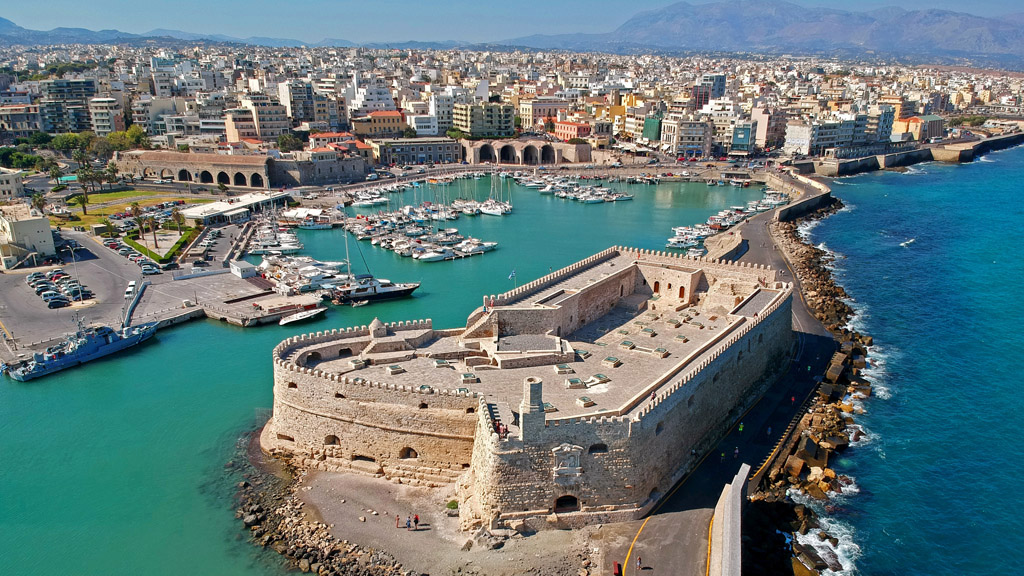
Koules Fortress, strategically placed at Heraklion’s old harbour entrance, controlled maritime activity and symbolized Venetian power during their rule over Crete. Its robust structure, designed for defense, offers panoramic views of the sea and Heraklion, enhancing its appeal to visitors.
Koules was constructed in the early 16th century by the Venetians to replace a Byzantine tower, forming a critical part of Heraklion’s defenses against naval attacks. It withstood battles, sieges, and shifts in Mediterranean power, notably during the 17th-century Ottoman siege. The fortress later served the Ottoman Empire and briefly functioned as a prison. Today, it represents Heraklion’s maritime heritage and its encounters with diverse civilizations.
Renovations and restorations over the years preserved its structure. The fortress attracts thousands of annual visitors, though exact daily counts are undetermined. Koules is located 5 kilometers (3 miles) from Heraklion International Airport and is accessible within 10–15 minutes by car, depending on traffic.
Visitors to Koules explore its massive stone walls, chambers, and passageways, which narrate tales of battles and sieges. Inscriptions and Venetian insignia adorn the walls, reflecting its historical legacy. Panoramic rooftop views capture the Mediterranean Sea and Heraklion’s vibrant activity. Occasional cultural events, exhibitions, and performances enrich the visitor experience.
Koules engages children with its maze-like structure, offering interactive tours that highlight stories of pirates, sieges, and maritime adventures. The rooftop view of boats entering and leaving the harbour captivates young and adult visitors alike. Safety measures are in place, though some areas with uneven flooring or low ceilings require caution, particularly for children.
Koules Fortress charges an entrance fee of €2. It remains open daily except Mondays, with operating hours from 8:30 am to 7:00 pm between April 1st and October 31st, and from 8:30 am to 3:00 pm during the winter season.
Visitors can enjoy nearby dining options that complement their visit. Ligo Krasi Ligo Thalassa, 0.2 kilometers (0.1 miles) from the fortress, offers Cretan seafood and local wines in a seaside setting. I Vardia Restaurant, 0.1 kilometers (0.06 miles) away, serves traditional Cretan dishes in a rustic atmosphere with views of Koules Fortress. Herb’s Garden, located 0.2 kilometers (0.1 miles) away, provides rooftop dining with herbal-infused dishes and panoramic views of Heraklion and the Mediterranean.
Hotels near Koules include Mirabello Hotel, Marin Hotel, and Lato Boutique Hotel. Mirabello Hotel, 0.53 kilometers (0.33 miles) from the fortress, offers comfortable accommodations blending modern amenities with traditional Cretan hospitality. Marin Hotel, located 0.39 kilometers (0.24 miles) from the fortress near the harbour, provides a mix of convenience and scenic views, ideal for exploring Heraklion’s maritime heritage. Lato Boutique Hotel, 0.32 kilometers (0.2 miles) away, features uniquely designed rooms with panoramic views of Koules and the Aegean, offering a personalised and exclusive experience.
4. Pay respects at Kazantzakis’ Tomb
Visitors of Heraklion must not miss to pay respect at Kazantzakis Tomb. The Kazantzakis’ Tomb, which is situated on the city walls of Heraklion, is the final repose of Nikos Kazantzakis, a renowned Greek author recognised for important works like “Zorba the Greek”.
Nikos Kazantzakis died due to Leukaemia in 1957. The author was not interred in an Orthodox Christian cemetery as a result of the controversy surrounding the author’s thoughts regarding religion. Kazatzakis’ grave, which looks over Heraklion, is instead located on the Martinengo Bastion, symbolising the author’s independence.
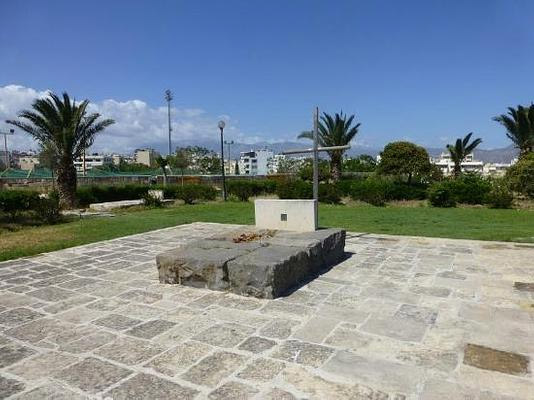
The Tomb of Nikos Kazantzakis, located on the Martinengo Bastion outside Heraklion’s Venetian walls, serves as a key cultural landmark in Crete. Approximately 5 to 6 kilometers (3 to 4 miles) from Heraklion Airport, it is accessible by car in 10 to 15 minutes. The tomb bears the inscription, “I hope for nothing. I fear nothing. I am free,” reflecting Kazantzakis’ philosophy. Its elevated location provides panoramic views of Heraklion, enhancing the site’s appeal.
The number of daily visitors to the Tomb of Kazantzakis is not documented, but Crete’s growing tourism since the 1970s suggests a steady influx. Visitors often engage with Kazantzakis’ legacy and the broader cultural and historical context of the site. The location is safe for all ages, though basic precautions are advised. There is no entrance fee, but transportation can be a challenge for those without private vehicles. Day tour packages, priced between €301.82 ($329.70, £262.84) and €610.80 ($667.21, £531.73) for groups of eight, include the tomb in their itineraries.
Nearby dining options enrich the visitor experience. Oti Thes, 0.1 kilometers (0.06 miles) from the tomb, offers authentic Cretan cuisine in a modern setting, blending traditional flavors with contemporary presentation. Kafenio o Lakkos, 0.2 kilometers (0.12 miles) away, provides Greek coffee and vegan-friendly meals in a casual café atmosphere. Vourvouladiko, also 0.2 kilometers from the tomb, serves classic Greek dishes with live evening music, creating a lively dining environment.
Accommodation options near the Tomb of Kazantzakis cater to diverse preferences. The Galaxy Hotel Iraklio, 0.45 kilometers (0.28 miles) from the tomb, offers luxurious rooms and high-quality dining, ranking as a top choice among Heraklion hotels. The Olive Green Hotel, located 0.58 kilometers (0.36 miles) away, emphasizes sustainability, providing modern amenities while promoting eco-friendly practices. The Aquila Atlantis Hotel, 0.65 kilometers (0.4 miles) from the tomb, combines stylish design with views of Heraklion’s harbor, offering a comfortable stay infused with Cretan culture. These options ensure visitors enjoy both convenience and quality during their time in Heraklion.
5. Experience the Historical Museum of Crete
Tourists enjoy their journey in Heraklion as they experience the Historical Museum in Crete. Heraklion’s Historical Museum of Crete stands as a complete witness to the island’s rich tapestry of history. The museum spans centuries from the first Christian era to the current age which deftly integrates elements of art, culture and daily life. The museum’s extensive collection of items includes Byzantine artwork, sculptures, coins and textiles in addition to more modern historical artefacts that depict Crete’s turbulent past under many rulers and influences.
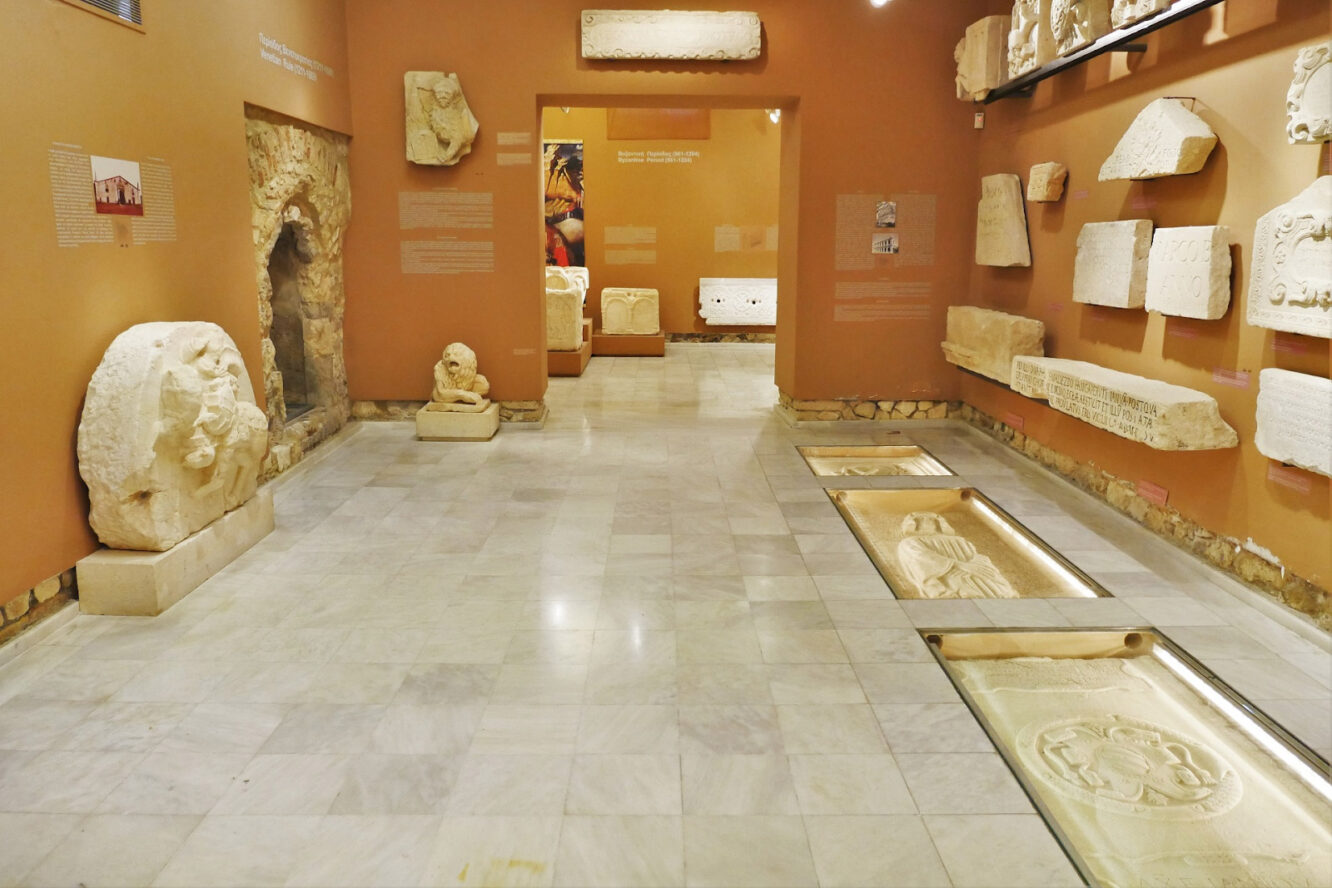
The Historical Museum of Crete, established in 1953 by the Society of Cretan Historical Studies, preserves and exhibits the island’s cultural heritage. Its functions extend beyond preservation, operating as a research and educational hub with lectures, conferences, and seminars on Cretan history and its Mediterranean connections. It also serves as a repository for historical artefacts.
Crete’s tourism grew significantly in the 1970s and continues today. The museum is located at 27 Sofokli Venizelou Ave in Heraklion, five kilometers (3 miles) from the airport, with a travel time of 10–15 minutes by car. A visit to the museum provides a chronological overview of Crete’s history, from early Christian basilicas and Byzantine art to Venetian crafts, Ottoman and German occupation artefacts, and 20th-century documents. The museum houses two El Greco paintings and a detailed model of Heraklion during the Venetian period.
Children engage with history at the museum through interactive exhibits, workshops, and themed tours, enabling them to learn about historical eras, arts, and crafts. Models of towns and ships help young visitors visualize historical narratives.
The museum ensures visitor safety through regular security measures. Admission costs €5 for adults, €3 for students and pensioners, and is free for children under 12 as of early 2025.
Nearby dining options include Piazza Pastarella, Arismari & Varsamo, and Avli Tou Devkaliona. Piazza Pastarella, located less than a mile from the museum, serves Italian-inspired dishes like pasta and pizza in a cosy setting. Arismari & Varsamo specializes in Cretan and Greek cuisine, offering vegetarian, vegan, and gluten-free options, emphasizing regional ingredients. Avli Tou Devkaliona serves Greek and Mediterranean dishes in a courtyard setting, showcasing the area’s culinary traditions.
Hotels near the museum include the Atrion Hotel, GDM Megaron Historical Monument Hotel, and Olive Green Hotel. Atrion Hotel, 0.1 kilometers (0.06 miles) from the museum, offers a comfortable stay and is popular for its proximity to the museum. GDM Megaron Historical Monument Hotel, located 0.7 kilometers (0.4 miles) away, combines historic architecture with modern amenities, providing an immersive experience tied to Crete’s heritage. Olive Green Hotel, 0.5 kilometers (0.3 miles) away, integrates eco-friendly practices and reflects Cretan culture and nature, creating a tranquil, culturally enriched atmosphere for guests.
6. Explore the Palace of Phaestos on a day trip
Another activity to do in Heraklion is to explore the Palace of Phaestos on a day trip. The Palace of Phaestos, spelt “Phaistos” or “Faistos,” is one of Crete’s most prominent archaeological sites, second to the legendary Palace of Knossos. The Minoan palace complex provides a rare view into the island’s Bronze Age civilisation. Phaestos has been kept in its natural state, providing visitors with a raw and true impression of its ancient architecture and layout, unlike Knossos, which was heavily reconstructed.
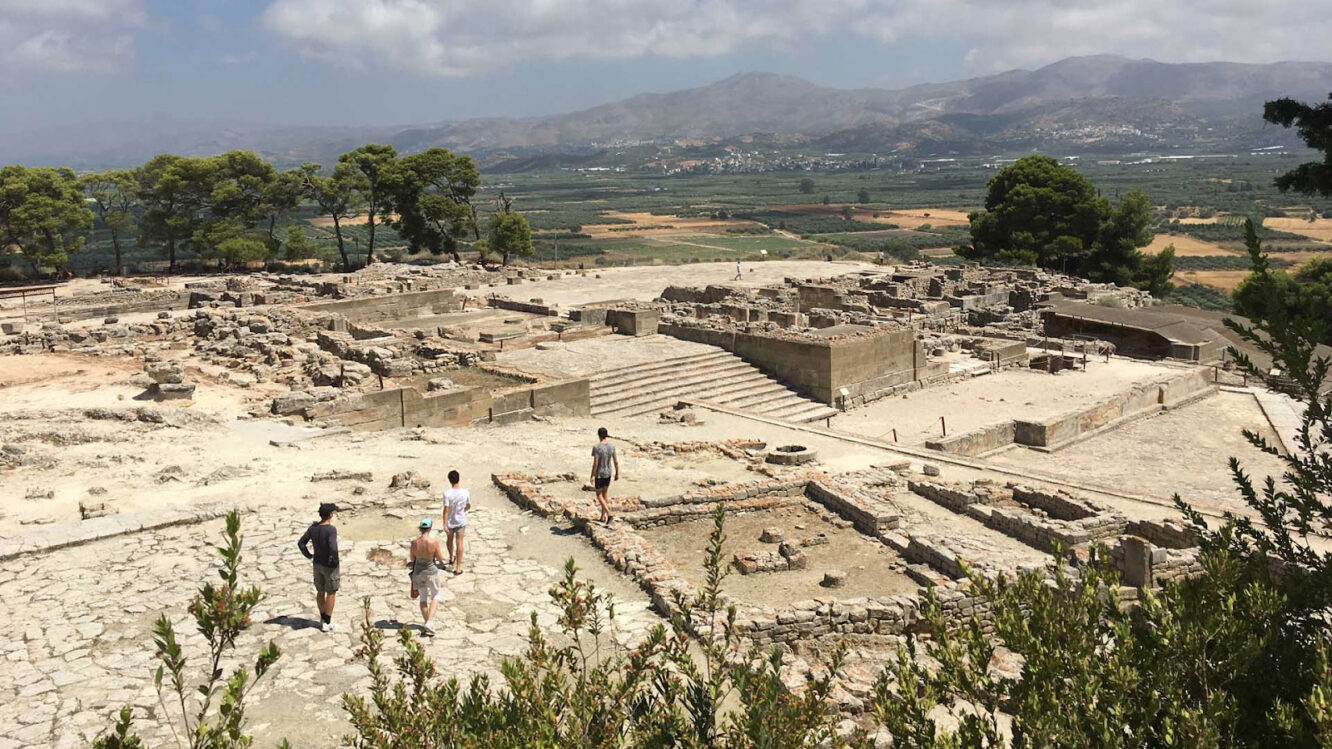
Tourism to Phaestos expanded with Crete’s tourism growth since the 1970s. Its location 62 kilometers (38 miles) from Heraklion Airport makes it accessible by car in about an hour. Visitors explore courtyards, staircases, and storerooms that reveal Minoan architectural and social practices. The site includes the West Propylaeum with its staircase, the Central Court used for ceremonies, and large pithoi (storage jars), highlighting storage’s importance in Minoan life. The Phaistos Disc, a unique artifact with undeciphered symbols, adds archaeological significance. Palace terraces offer sweeping views of nearby plains and mountains.
Families engage in interactive activities like treasure hunts and workshops on Minoan culture, myths, and crafts. Apps and guides enrich their exploration of Minoan legends. Safety recommendations include wearing comfortable footwear due to uneven terrain. Entry costs €8 ($8.70, £7) for adults and €4 ($4.35, £3.50) for reduced tickets. The site operates daily from 8 am to 6 pm.
Nearby dining options enhance the experience. The Lamb House, located 0.3 kilometers (0.2 miles) from the site, specializes in lamb dishes. Taverna Agios Ioannis, 0.4 kilometers (0.25 miles) away, serves Greek and Mediterranean cuisine. Alekos Taverna, 1.1 kilometers (0.7 miles) away, is known for seafood and Mediterranean dishes.
Accommodations nearby include Matala Dimitris Villa, 4.36 kilometers (2.7 miles) away, offering breakfast, hiking, and car rental. Armonia Hotel, 4.8 kilometers (3 miles) away, provides a pool, bar, and tranquil setting. Matala Hostel, 5.2 kilometers (3.2 miles) away, caters to budget-conscious travelers with a social atmosphere, 24/7 front desk, and pool facilities. These amenities ensure a comfortable stay while exploring Crete’s historical sites.
7. Visit the Heraklion Archaeological Museum
The Heraklion Archaeological Museum, established in the late 19th century and shaped significantly in the 20th century, serves as a central repository for artefacts from Crete’s ancient Minoan sites, particularly Knossos. Over the years, the museum expanded its holdings and exhibits, becoming a monument to Crete’s rich history and diverse cultures.
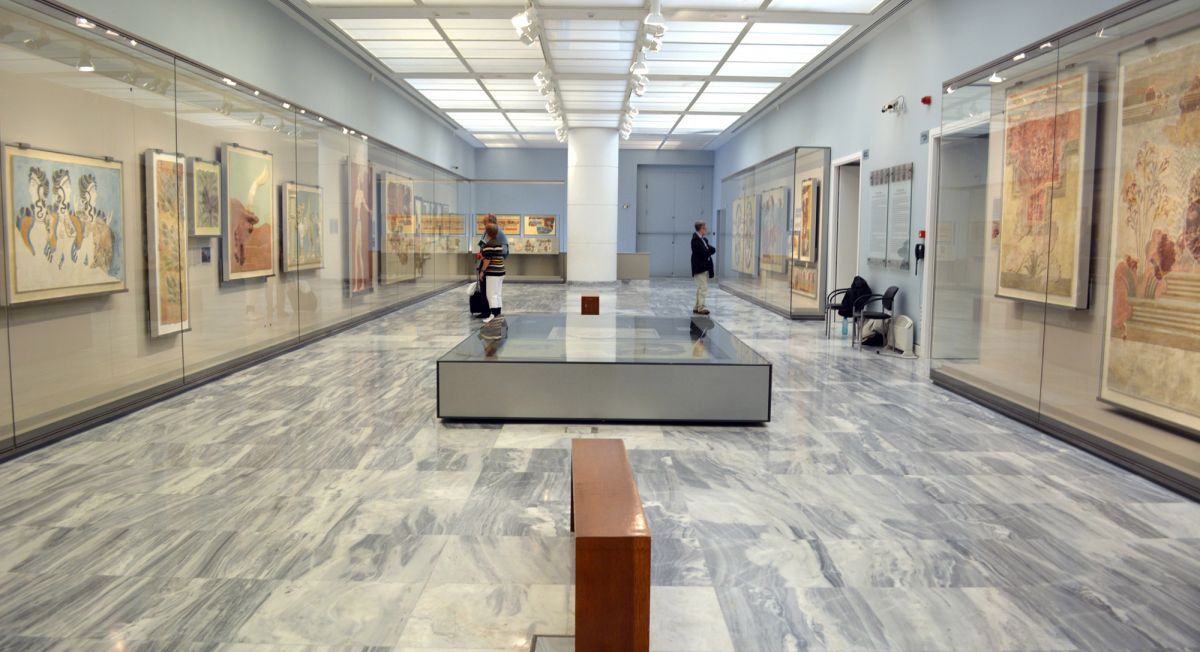
Tourism to Crete has surged since the 1970s, though precise daily visitor numbers to the museum remain unavailable. The museum is located in Heraklion City on Xanthoudidou Street, approximately 4 kilometers (2.5 miles) from Nikos Kazantzakis International Airport. Driving from the airport to the museum takes about 10 minutes, depending on traffic.
The museum’s collection focuses on Minoan artefacts, including ceramics, frescoes, sculptures, jewellery, tools, and iconic pieces like the Phaistos Disc, Linear B Tablets, Snake Goddess figurines, Bull’s Head rhyton, and the Bull-leaper’s fresco. Each exhibit offers insights into the culture, economy, and lifestyle of ancient Crete.
Children experience history through interactive exhibitions and storytelling tours designed to bring artefacts to life. Replicas of ancient buildings and educational screens create an engaging, hands-on learning environment. The museum prioritises visitor safety with security guards and monitoring equipment.
The entrance fee to the Heraklion Archaeological Museum is €4 ($4.50, £3.50). The museum operates daily from 8:30 am to 8:00 pm, with the best visiting hours between 1:30 pm and 8:00 pm. A full visit takes about 2 hours and 30 minutes.
Nearby restaurants include Haris Creperie, 626 All Day Lounge & City Garden, and ML Espresso Bar. Haris Creperie, less than 1 kilometer (0.6 miles) from the museum, serves a variety of sweet and savoury crepes. The 626 All Day Lounge, 0.1 kilometers (0.06 miles) away, offers a modern indoor and outdoor dining experience in a tranquil urban setting. ML Espresso Bar, 1 kilometer (0.6 miles) from the museum, specialises in high-quality coffee and pastries, perfect for a quick refreshment.
Nearby hotels include the GDM Megaron Historical Monument Hotel, Olive Green Hotel, and Aquila Atlantis Hotel. The GDM Megaron Hotel, 0.3 kilometers (0.18 miles) away, combines historical architecture with modern comforts and is rated the top hotel in Heraklion by TripAdvisor. The Olive Green Hotel, 0.1 kilometers (0.06 miles) from the museum, integrates sustainable practices with contemporary design. The Aquila Atlantis Hotel, also 0.1 kilometers (0.06 miles) away, offers a mix of convenience, elegance, and excellent services, making it an ideal choice for city visitors.
8. Immerse in the art at El Greco Museum, Fodele
One way to enjoy one’s Heraklion trip is to immerse in the art at El Greco Museum, in Fodele. The El Greco Museum in the town of Fodele is home to some of the preserved works of a famous painter, sculptor and architect of the Spanish Renaissance named Domenikos Theotokopoulos, better known as El Greco. The town of Fodele is thought to be El Greco’s birthplace. The El Greco Museum in Fodele displays reproductions of the painter’s famous artworks and provides insights into the painter’s early life in Crete before moving to Spain.
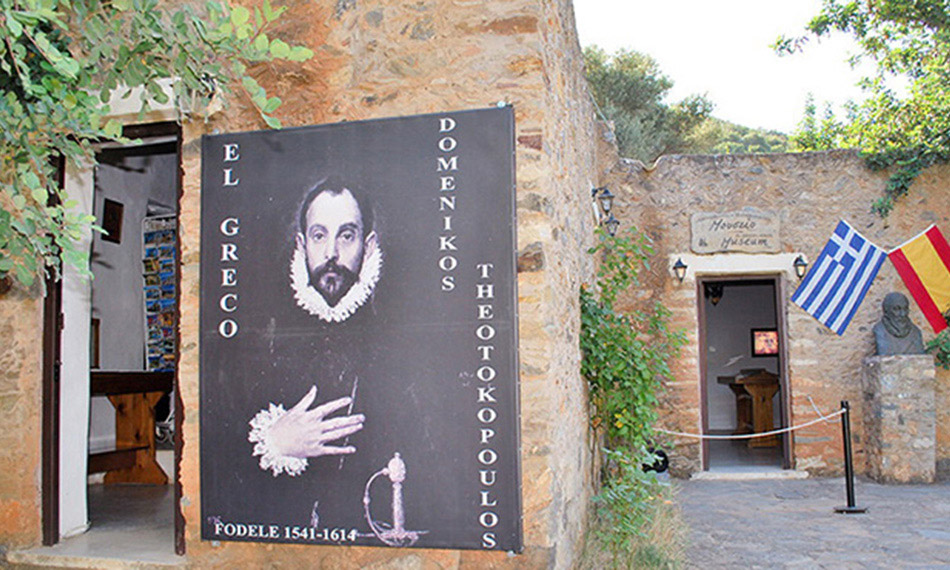
The El Greco Museum in Fodele commemorates the renowned painter, widely acknowledged as a native of Crete despite debate over his exact birthplace. The museum occupies a building believed to be his family home and features Venetian-era architecture. Established in the 20th century, the museum highlights El Greco’s formative years in Crete before his artistic journey to Venice and Toledo.
Fodele, located west of Heraklion, is about 27 kilometers (17 miles) from Nikos Kazantzakis International Airport, with a drive time of 30-35 minutes depending on traffic.
The museum exhibits replicas of El Greco’s famous paintings, a reconstructed workspace, Bible-inspired artworks, and personal artefacts. Informative displays explore the artist’s childhood influences. The building’s Venetian design enhances the cultural experience, while Fodele’s scenic surroundings underline the artist’s ties to the village.
Children engage in interactive art and history programmes at the museum, designed to make learning enjoyable. Fodele’s safe streets and natural charm create a welcoming environment for young visitors to explore and play.
Visitors feel secure exploring the El Greco Museum in Fodele and the surrounding village. Admission to the museum is affordable, with a fee of 2.20 € ($2.40, £1.90) in April 2017, rising slightly to 2.50 € ($2.70, £2.10) by 2025. Groups of ten or more people pay a reduced fee of 2 € ($2.20, £1.70), and younger children are admitted free.
Nearby restaurants include El Greco Café, To Giasemi, and Café Bistro Domenico. El Greco Café, located 0.5 kilometers (0.3 miles) from the museum, offers coffee, refreshments, and light meals, emphasizing its thematic link to the painter El Greco. Visitors enjoy a relaxed ambiance while dining. To Giasemi, translating to “The Jasmine,” is also within 0.5 kilometers (0.3 miles) of the museum and serves traditional Cretan and Greek dishes, providing a flavorful introduction to local cuisine. Café Bistro Domenico, named after El Greco’s birth name, Domenico, is another dining option 0.5 kilometers (0.3 miles) away. It combines casual dining with elegance, offering everything from snacks to hearty meals in a sophisticated setting.
Nearby accommodations include Happy Cretan Suites, Irida Hotel, and Fodele Beach & Water Park Holiday Resort. Happy Cretan Suites, located 3.4 kilometers (2.1 miles) from the museum, combines traditional Cretan aesthetics with modern comforts, offering spacious accommodations and scenic island views. Irida Hotel, situated 3.9 kilometers (2.4 miles) away in Agia Pelagia, provides guests with stunning sea views and beach access, offering a tranquil environment for relaxation. Fodele Beach & Water Park Holiday Resort, 1.2 kilometers (0.7 miles) from the museum, blends beachside luxury with the excitement of a water park, making it an ideal choice for families and adventurous travelers.
9. Shop in the Old Town
Shopping in Heraklion’s Old Town offers a unique experience within its narrow alleys, historic buildings, and diverse architectural styles. The Old Town reflects the city’s layered history, showcasing Venetian, Byzantine, and Ottoman influences alongside modern establishments. Visitors encounter lively markets, artisan shops, cozy cafes, and traditional tavernas. The Old Town remains both a historical treasure and a vibrant hub of Heraklion’s daily life.
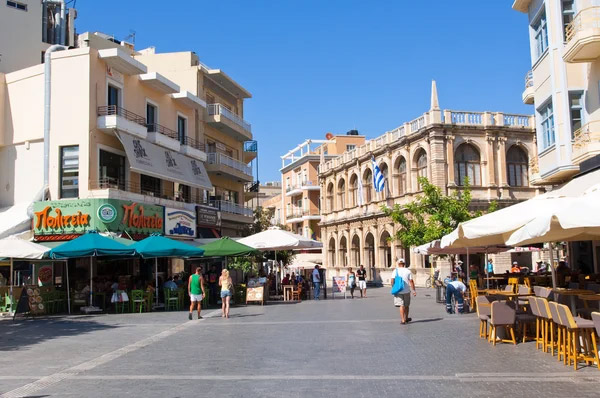
Heraklion’s Old Town has been the city’s focal point for decades, shaped by an intricate history of events and influences. Established in ancient times, the Old Town witnessed the rise and fall of civilizations. The Venetian era profoundly shaped its architecture, with landmarks like the Koules Fortress and the Loggia originating from that period. Ottoman rule followed, introducing new architectural and cultural elements. Despite invasions, battles, and natural disasters, the Old Town preserved its charm, standing as a testament to its resilient and rich heritage.
The Old Town of Heraklion lies within its medieval walls, 5 kilometers (3 miles) from Heraklion’s International Airport, Nikos Kazantzakis. Driving from the airport to the Old Town typically takes 10-15 minutes, depending on traffic.
The Old Town holds significant historical and cultural landmarks. The Koules Fortress dominates the harbor, while the Venetian Loggia serves as the Town Hall. Visitors can walk the historic city walls, explore the Saint Minas Cathedral, admire the Morosini Fountain, and discover small churches with unique histories. Markets, artisan shops, and local cafes showcase Cretan culture and cuisine.
Children enjoy both education and fun in the Old Town. Scavenger hunts teach local history, street vendors sell ice cream, and workshops introduce traditional crafts and art techniques. Street performers and musicians provide entertainment in open spaces.
Heraklion’s Old Town is open to the public without admission fees, though museums and certain sites may charge entry. The area is generally safe, but visitors should remain cautious in crowded places and safeguard valuables.
Nearby restaurants include Ntoré Gastronomy & Symposia, Petousis Restaurant, and Thigaterra. Ntoré offers upscale dining with Cretan flavors blended with modern techniques, inspired by ancient Greek feasting. Petousis provides authentic Cretan and Greek cuisine in a welcoming atmosphere. Thigaterra focuses on organic, farm-to-table dishes highlighting fresh, local ingredients.
Hotels in Heraklion Old Town include the GDM Megaron Historical Monument Hotel, Galaxy Hotel Iraklio, and Aquila Atlantis Hotel. The GDM Megaron offers proximity to historical attractions. The Galaxy Hotel features contemporary design, gourmet dining, and a relaxing pool area. Aquila Atlantis Hotel provides easy access to the city’s vibrant life and landmarks.
10. Explore Lakkos’ Old Quarter
Exploring Lakkos’ Old Quarter enriches any visit to Heraklion. The Old Quarter of Lakkos in Heraklion is an intriguing mix of history, culture and urban renewal. Lakkos has evolved over time to become one of Heraklion’s most authentic and characterful neighbourhoods, being once considered a less desirable section of the city.
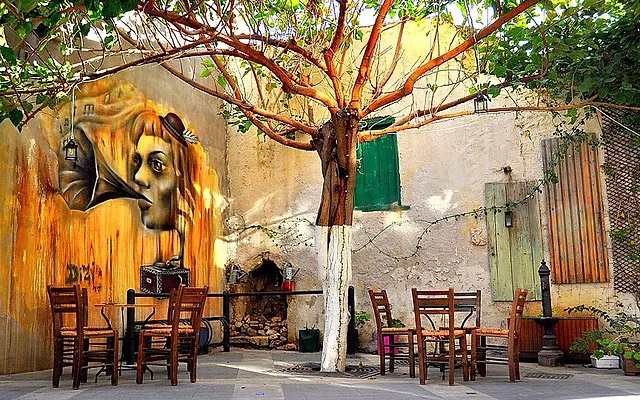
Lakkos’ Old Quarter, with its narrow streets, historic buildings, and small establishments, reflects its rich history and enduring community ties. The district represents Heraklion’s blend of historical depth and modern redevelopment, showcasing both its past and progressive transformation.
In the 19th and early 20th centuries, Lakkos served as Heraklion’s red-light district, filled with entertainment venues, pubs, and brothels. It hosted a mix of soldiers, travelers, and locals, gaining a reputation for both vice and vibrancy. As Heraklion modernized, efforts began to repurpose and revitalize the area.
The late Ottoman-era structures in Lakkos were recognized for their historical significance, leading to restoration projects that preserved its architectural heritage. Today, Lakkos features cultural venues, art spaces, and community centers, while remnants of its colorful past linger in its atmosphere. The quarter is now a favored destination for visitors seeking authentic Cretan experiences.
Lakkos’ Old Quarter lies at the heart of Heraklion, just 4–5 kilometers (2.5–3.1 miles) from Heraklion International Airport, Nikos Kazantzakis. The journey takes approximately 10–15 minutes by car, making it easily accessible to visitors.
In Lakkos’ Old Quarter, visitors admire restored houses, street art, and Ottoman-era architecture. Local museums, art galleries, and workshops showcase the district’s rich history and artistic revival. Traditional pubs coexist with modern cafes, while cultural institutions host musical and artistic performances, establishing Lakkos as a growing cultural hub in Heraklion.
Children find Lakkos engaging through its vibrant street art and interactive workshops led by local artists. They explore small parks, secret courtyards, and pedestrian-friendly streets. Family-friendly tours and visits to cafes and bakeries enrich their experience with local flavors and culture.
Lakkos’ Old Quarter offers a safe environment, especially after recent revitalization, but visitors are advised to remain cautious, particularly at night. Walking the streets is free of charge, though some attractions, museums, and venues may require an admission fee.
Nearby restaurants include Parasties, Agkyrovolia Cafe Mezedopoleio, and Mare Coffee Bar & Food. Parasties serves authentic Cretan cuisine in a welcoming, rustic setting. Agkyrovolia Cafe Mezedopoleio specializes in traditional “meze” dishes, creating a cultural dining experience. Mare Coffee Bar & Food offers freshly brewed coffee paired with Mediterranean-inspired meals.
Hotels near Lakkos include the Galaxy Hotel Iraklio, Aquila Atlantis Hotel, and Lato Boutique Hotel. The Galaxy Hotel Iraklio combines modern comfort with luxury, featuring a spacious pool and fine dining. Ranked first among Heraklion hotels on TripAdvisor, it offers a premium experience. Aquila Atlantis Hotel provides contemporary elegance with views of the port and amenities such as free parking, airport transfers, and a spa. It ranks as Heraklion’s second Best Value hotel. Lato Boutique Hotel blends modern design with Cretan culture, offering views of the Venetian Fortress and Old Harbour. Its central location and rooftop restaurant make it a popular choice, ranking third Best Value in the city.
11. Marvel at the Morosini Fountain in Lion Square
Marveling at the Morosini Fountain in Lion Square is a notable activity in Heraklion. The Morosini Fountain, also called the Lions’ Fountain, stands as a prominent monument in Heraklion’s Lion Square. Built by the Venetians in the 17th century during their rule over Crete, the fountain was part of a larger initiative to enhance the city’s infrastructure and provide fresh water. Its defining feature is the four stone lions, each spouting water from its jaws.
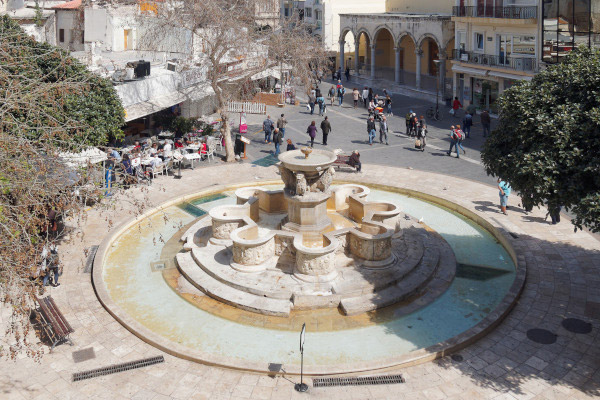
The Morosini Fountain in Heraklion, Crete, was commissioned in 1628 by Francesco Morosini, the Venetian governor of Crete. Named after Morosini, the fountain was part of a larger aqueduct project that transported water from the Archanioti Canyon springs to Heraklion’s city center. The fountain symbolized Venetian power and control over the island, serving both practical and symbolic purposes.
The number of daily visitors to the Morosini Fountain remains undocumented. However, Crete’s tourism has surged significantly since the 1970s, likely increasing visits to this historic site.
The Morosini Fountain is situated in Eleftheriou Venizelou Square, commonly called Lion Square, in Heraklion. It is located approximately 5 kilometers (3.1 miles) from Heraklion International Airport (Nikos Kazantzakis), with a drive taking 10–15 minutes depending on traffic.
The fountain features intricate Venetian-era carvings and sculpted lions, its most iconic elements. The square is surrounded by historic buildings blending Venetian and Ottoman architecture, while nearby cafes, restaurants, and street performers contribute to its lively atmosphere, merging history with modern Heraklion’s energy.
Children enjoy the sight of water flowing from the lions’ mouths and playing in the open square. Street performers often entertain young visitors with engaging acts, making the square a family-friendly space.
Visitors to the Morosini Fountain experience a secure environment, day and night, though they are advised to remain cautious about their surroundings and belongings, as in any popular tourist area. The fountain is a free public attraction, open to all without an entrance fee.
Svelto Coffee & Snack, Bao Bunny Street Gastronomy, and Valide Brunch Cafe are restaurants near the Morosini Fountain in Lion Square, each located 0.2 kilometers (0.12 miles) away.
Svelto Coffee & Snack offers breakfast, brunch, lunch, and dinner in a relaxed setting. Visitors enjoy freshly brewed coffee and light snacks, with a focus on quick, quality service ideal for short breaks.
Bao Bunny Street Gastronomy specializes in bao buns, combining traditional Asian flavors with modern culinary techniques. Its trendy approach attracts food enthusiasts seeking creative street food experiences.
Valide Brunch Cafe focuses on breakfast and brunch, offering a menu that includes both classic dishes and inventive options. Diners enjoy hearty meals and refreshing beverages, including beer, in a cozy atmosphere.
Hotels near the Morosini Fountain include the Olive Green Hotel, Dom Boutique Hotel, and ibis Styles Heraklion Central. The Olive Green Hotel, 0.7 kilometers (0.43 miles) from the fountain, integrates eco-friendly and sustainable practices inspired by Crete’s olive groves. It features public parking, free breakfast, and car hire services.
Dom Boutique Hotel, just 0.13 kilometers (0.08 miles) from the fountain, provides an intimate experience with elegant design and personalized service, catering to guests seeking a stylish stay.
Ibis Styles Heraklion Central, 0.18 kilometers (0.11 miles) from the fountain, combines affordability, convenience, and modern design. The hotel offers contemporary furnishings and reliable service, appealing to both business and leisure travelers.
12. Relax at Ammoudara Beach
Tourists benefit from visiting Ammoudara Beach to enhance their Heraklion experience. Ammoudara Beach, located near Heraklion, is a renowned coastal destination in Crete, known for its expansive sandy shores and clear blue waters. Its accessibility and amenities make it a favorite among locals and tourists.
Ammoudara Beach features golden sands, loungers, umbrellas, and beachside eateries, offering comfort and convenience for visitors.
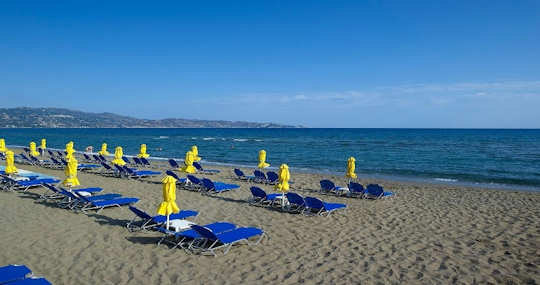
Ammoudara Beach offers calm waters, making it suitable for swimmers of all experience levels. The beach accommodates diverse preferences, including water sports, sunbathing, and seaside relaxation.
Ammoudara Beach has long been a popular leisure destination. Over the centuries, Crete’s coastline has been shaped by Minoan, Venetian, and Ottoman influences. Ammoudara transformed from a modest coastal strip into a developed beach area with modern infrastructure, accommodations, and recreational facilities, paralleling Heraklion’s rise as a major tourist hub.
Visitor numbers to Ammoudara Beach remain undocumented due to a lack of public data. Crete’s tourism has grown significantly since the 1970s, likely contributing to increased activity in Heraklion, including Ammoudara Beach.
Ammoudara Beach lies on Crete’s northern coast, a few kilometers west of Heraklion’s city center. Nikos Kazantzakis International Airport is approximately 10 kilometers (6.2 miles) away, requiring a 15–20 minute drive under normal traffic conditions.
Visitors to Ammoudara Beach enjoy golden sands, turquoise waters, and small boats drifting in the distance. Adjacent to the beach, a lively promenade features shops, cafes, and restaurants. The sunsets are striking, and nearby patches of native vegetation reflect the region’s natural beauty.
Ammoudara Beach provides activities for children, including shallow waters for supervised swimming, sandcastle building, and water sports such as paddleboarding or jet skiing for older children. Ice cream stands and snack shacks offer refreshments, and some localities organize beach games or child-friendly activities to entertain young visitors.
Tourists at Ammoudara Beach experience a safe environment, though swimming requires caution, particularly in strong currents, with children needing constant supervision. Access to public beaches in Crete, including Ammoudara, is free, but amenities like sunbeds and umbrellas are available for rent.
Teatro Beach Bar Restaurant, Heaven Beach, and Cabana Plage are restaurants near Ammoudara Beach. Teatro Beach Bar Restaurant offers beachside dining with gourmet dishes, drinks, and live entertainment, creating a vibrant atmosphere. The restaurant is located less than a mile from Ammoudara Beach.
Heaven Beach focuses on freshly prepared seafood and overlooks the sea, providing a peaceful dining environment. The restaurant is 0.2 kilometers (0.12 miles) from Ammoudara Beach.
Cabana Plage combines Mediterranean and French-inspired cuisine in a cabana-style setting, designed for a cozy and relaxed experience. It is located 0.1 kilometers (0.06 miles) from Ammoudara Beach.
Hotels near Ammoudara Beach include Paralos Lifestyle Beach, Petousis Hotel & Suites, and Civitel Creta Beach. Paralos Lifestyle Beach highlights modern beachside comfort and holistic well-being, offering stylish amenities 0.6 kilometers (0.37 miles) from Ammoudara Beach.
Petousis Hotel & Suites integrates traditional Cretan hospitality with contemporary accommodations, providing rooms and suites 0.23 kilometers (0.14 miles) from Ammoudara Beach.
Civitel Creta Beach delivers refined accommodations and direct access to the beach, offering well-appointed rooms and amenities 0.53 kilometers (0.33 miles) from Ammoudara Beach.
13. See the beauty of Agios Titos Church
Visitors or Heraklion need to see the beauty of Agios Titos Church. The Agios Titos Church is a major religious and historical monument in Heraklion, Crete. It is a symbol of the city’s rich religious legacy and its convoluted history of influences, invasions and restorations, dedicated to Saint Titus.
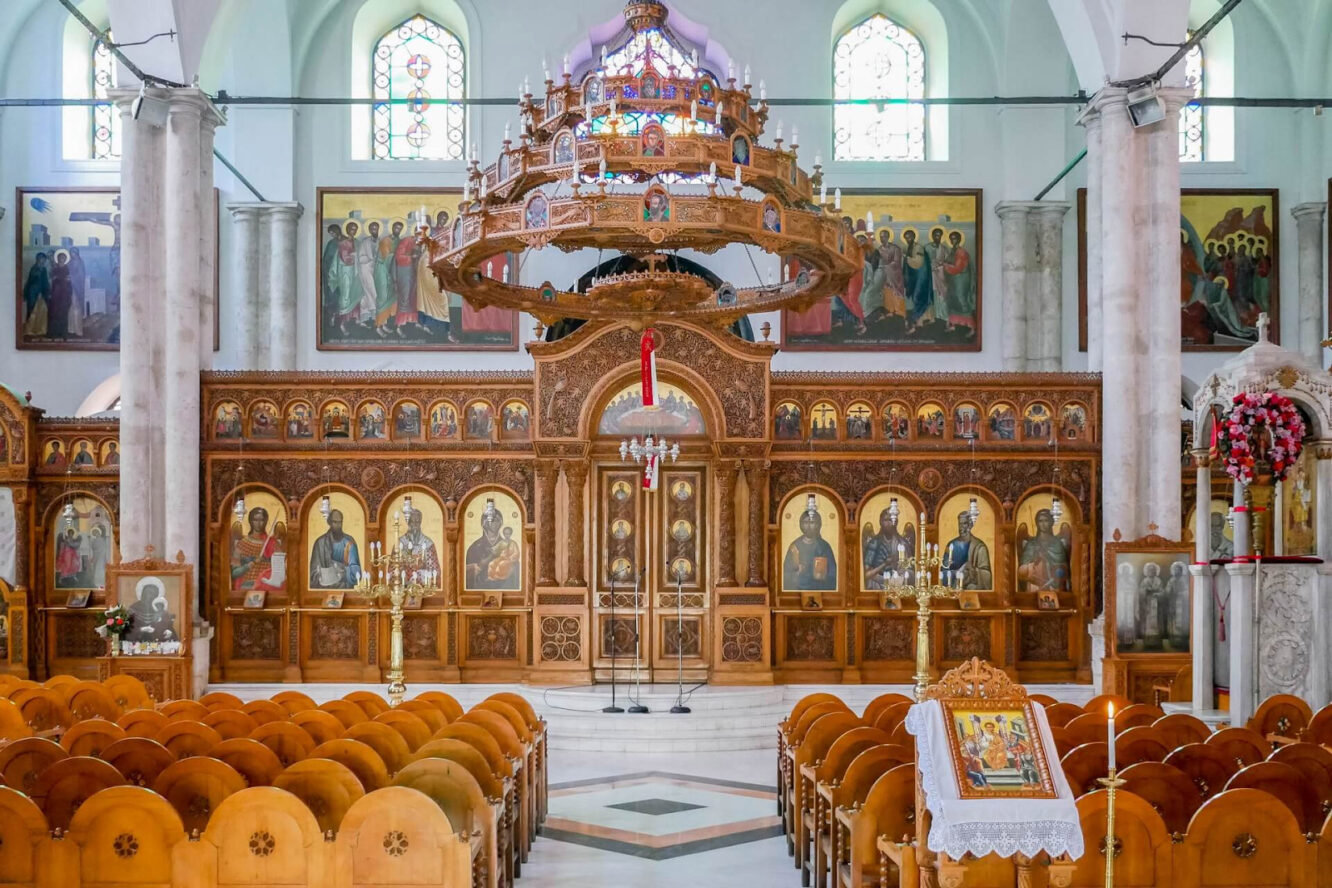
Agios Titos Church reflects epochs in its architecture, primarily the Byzantine era, when it was first constructed. The church embodies Heraklion’s history, functioning as a worship site and a tribute to the city’s past.
Agios Titos Church has origins in Crete’s Christian history, built in the 10th century during the Byzantine era to honor Saint Titus, a disciple of Apostle Paul and Crete’s first bishop. Following the Arab conquest, the church became a mosque. Under Venetian rule, a new church for Saint Titus was built elsewhere. During Ottoman rule, it was again converted into a mosque. After the Turks left Crete in the 20th century, Agios Titos Church reopened as a church, with renovations following an 1856 earthquake shaping its current form.
Agios Titos Church is positioned centrally in Heraklion’s Old Town around 5 kilometers (3 miles) from Heraklion International Airport, requiring a 10-15 minute drive depending on traffic.
Visitors to Agios Titos Church encounter holy artifacts, icons, and murals depicting biblical scenes. Its architecture integrates Byzantine, Venetian, and Ottoman influences. The central dome, adorned with intricate patterns, draws significant attention. The church houses Saint Titus’ skull in a silver reliquary, a relic highlighting its historical and spiritual significance.
For children, the church provides historical insights into its architecture, the civilizations that shaped it, and the sacred legends of its icons. Guided tours enhance engagement by narrating the church’s history. The church’s quiet environment introduces children to the idea of sacred spaces.
Visitors are generally safe exploring Agios Titos Church and its surroundings. Respectful behavior and modest dress are encouraged when entering religious sites. Entry to Greek churches is typically free, with voluntary donations suggested for maintenance. Visitors should confirm donation policies or updates through official church notices.
Restaurants near Agios Titos Church include Indigo Cafe, Pagopoieion, and Ploto Cafe Restaurant. Indigo Cafe, located close to the church, offers a mix of global flavors and Cretan delicacies in a relaxed cafe atmosphere. The menu features diverse cuisine alongside coffee and beverages. Pagopoieion, less than a mile from the church, specializes in ice creams, sorbets, and chilled beverages, offering local snacks in a casual setting. The name “Pagopoieion,” meaning “ice factory,” highlights its theme. Ploto Cafe Restaurant, also less than a mile away, presents a blend of traditional Cretan dishes with modern variations, served in a bright, breezy atmosphere combining casual dining with sophistication.
Hotels near Agios Titos Church include Olive Green Hotel, GDM Megaron Historical Monument Hotel, and Ibis Styles Heraklion Central. Olive Green Hotel, 0.2 kilometers (0.1 miles) from the church, integrates eco-friendly practices with modern amenities, offering excellent value among Heraklion accommodations. GDM Megaron, housed in a historic building 0.4 kilometers (0.25 miles) from the church, merges Crete’s cultural heritage with luxurious modern comforts, making it a top-rated choice. Ibis Styles Heraklion Central, 0.1 kilometers (0.06 miles) away, features stylish decor and offers amenities like car hire, baggage storage, and a bar, reflecting the quality associated with the Ibis brand.
14. Explore the Natural History Museum of Crete
Trips to Heraklion become more engaging when tourists visit the Natural History Museum of Crete. This key institution focuses on the Mediterranean region’s biodiversity, geology, and natural phenomena. The museum presents realistic dioramas, interactive displays, and actual specimens, offering detailed insights into Crete’s unique ecosystems, vegetation, and wildlife.
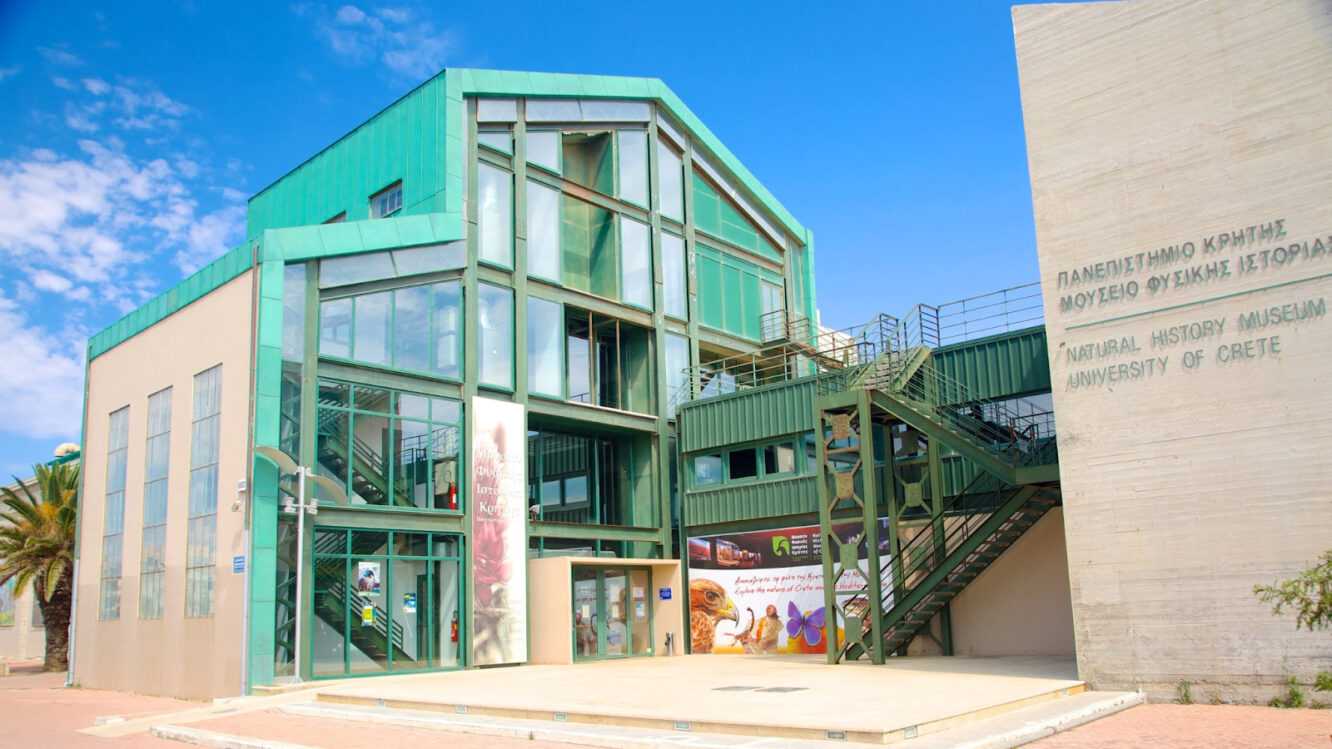
The Natural History Museum of Crete integrates exhibition, study, conservation, and education. It merges scientific knowledge with engaging presentations, appealing to nature enthusiasts, researchers, and families.
The University of Crete founded the museum in the late 20th century to research and highlight Crete’s natural resources while fostering environmental awareness. Since its inception, the museum has expanded exhibits and incorporated new scientific findings to enhance visitor experiences. It now serves as a major hub for environmental education and research in the Mediterranean and a prominent destination for both local and international visitors.
Tourist visitation statistics for the museum are unavailable, though Crete’s growing tourism since the 1970s has likely increased traffic to Heraklion and the museum. Located near Heraklion’s center, the museum is easily accessible, about 5–6 kilometers (3–4 miles) from Heraklion International Airport. A drive from the airport to the museum typically takes 10–15 minutes.
The museum’s diverse exhibits cover various ecosystems, from coastal zones to mountain landscapes. Detailed models depict native wildlife in their natural habitats, while interactive displays explain geological and climatic phenomena. Paleontological sections showcase fossil records and reconstructions, and temporary exhibitions address current environmental issues or recent scientific discoveries.
Children engage in hands-on activities with specimens, interactive exhibits, and multimedia programs that emphasize biodiversity and conservation. The museum offers educational programs focused on local wildlife and ecology. The ‘Discovery Centre’ allows children to explore nature through experimental activities and simulations, creating an active and enjoyable learning experience.
The Cretan Natural History Museum is safe for tourists. The museum follows basic safety rules and keeps its exhibits and facilities in good condition. The Natural History Museum of Crete charges a general admission price of €7.50. The entrance fee for children aged 4 to 8 years is reduced to €4.50, while children under the age of 4 are admitted free of charge. Senior citizens who are over the age of 65 receive a €4.50 discount.
Agkyrovolia Cafe Mezedopoleio, Parasties, and Mare Coffee Bar & Food are restaurants near the Natural History Museum in Crete. Agkyrovolia Cafe Mezedopoleio, located less than 1.6 kilometers (1 mile) from the museum, offers Greek dining with meze dishes, Cretan flavors, and beverages in a comfortable setting. Parasties, 0.2 kilometers (0.12 miles) from the museum, focuses on traditional Cretan cuisine in a rustic atmosphere emphasizing heritage. Mare Coffee Bar & Food, 0.2 kilometers (0.12 miles) from the museum, serves Mediterranean-inspired menus with sea views, functioning as both a coffee spot and a dinner venue.
Hotels near the museum include Atrion Hotel, Olive Green Hotel, and GDM Megaron Historical Monument Hotel. Atrion Hotel, 0.28 kilometers (0.17 miles) from the museum, combines modern amenities with traditional Cretan hospitality, suiting business and leisure travelers. Olive Green Hotel, 0.53 kilometers (0.33 miles) from the museum, provides a sustainable and stylish experience in Heraklion’s center, appealing to eco-conscious guests. GDM Megaron Historical Monument Hotel, 0.63 kilometers (0.39 miles) from the museum, offers luxury accommodations within a historical monument, blending Cretan heritage with modern comfort and offering excellent views.
15. Visit Heraklion’s Beaches
The last thing tourists must not miss when exploring Crete’s capital region is to visit Heraklion’s beaches. The beaches of Heraklion include a mix of quiet coves and more developed expanses of golden sand, appealing to all types of beachgoers. The beaches, surrounded by the azure seas of the Mediterranean, provide a perfect getaway from the hustle and bustle of the city, where one lounges in the sun, takes a dip or participates in water sports.
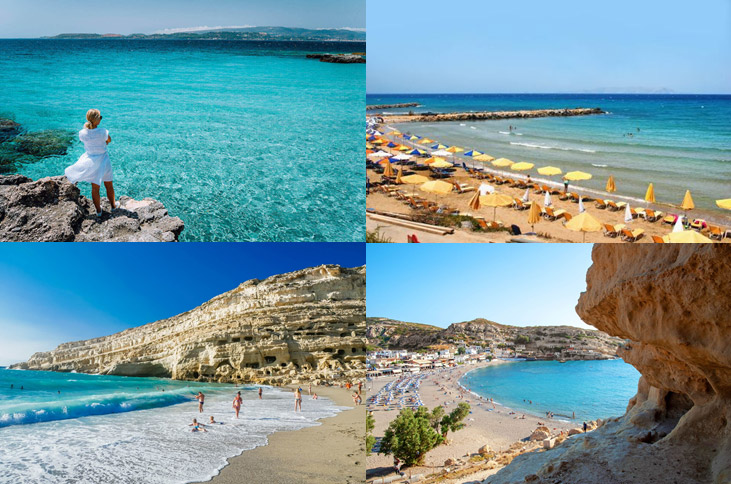
The shoreline of Heraklion has long been a popular destination for both locals and visitors. Beaches have been used as ports, fishing areas and places of rest and pleasure since prehistoric times. Many beaches have been developed as tourism in Crete improved, with the creation of resorts, restaurants and entertainment centres, while preserving their natural attractiveness and tranquillity.
The number of people who have visited Heraklion’s beaches is unknown. Crete’s tourism industry has grown considerably since the 1970s which has had an immediate impact on tourism in Heraklion, particularly on the beaches of Heraklion.
Beaches are found along the Heraklion region’s northern and southern shores. The distance from the airport varies depending on the beach. Most beaches on the northern coast are within 10-20 kilometres of the airport. The travel time takes between 15 and 30 minutes depending on the specific area and traffic.
Some of Heraklion’s beaches are backed by steep cliffs or littered with rock formations, producing fascinating contrasts. The glistening seas frequently show marine life, making them ideal snorkelling locations. The horizon gives breathtaking vistas as the sun sets below the Mediterranean.
Children build sandcastles, play organised beach games or take water sports instruction on Heraklion’s beaches. Many beaches offer shallow portions that are ideal for safe swimming for youngsters. Some resorts provide kid-friendly activities or excursions to see marine life.
The beaches of Heraklion are safe, but it is always a good idea to keep an eye on children, especially when they’re in the water. Obedience to any posted safety signs or flags is essential to avoid accidents. The majority of Heraklion’s beaches are free to visit, but some organised beaches charge for amenities such as sunbeds and umbrellas.
There are a lot of restaurants near Heraklion’s beaches. Some of the beaches include Alia Beach Restaurant, which is nestled directly on the sandy coastlines. The restaurant offers a delightful dining experience mixing fresh seafood with Mediterranean flavours, all served with panoramic views of the turquoise ocean.
The Coast Cafe Bar, a popular hotspot, is another example of Heraklion’s restaurants near the beach. The resto blends a laid-back beach ambience with a touch of urban sophistication, presenting a broad menu of light meals, refreshing drinks and cocktails. Thalassa, which means “sea” in Greek, offers an authentic Cretan dining experience, emphasising fresh fish dishes and traditional recipes that honour the island’s rich culinary heritage.
Heraklion’s beaches have several hotels nearby. Some closely situated hotels include the Out of the Blue Capsis Elite Resort, which is a magnificent hideaway in Heraklion with opulent accommodations ranging from elegant rooms to private villas.
Another example is the Agapi Beach Resort which reflects the warmth and hospitality of Crete. The hotel offers guests a harmonious blend of classic architecture and modern luxury. Creta Maris Beach Resort embraces the exuberant essence of Crete with its expansive facilities, which range from various pools and eating options to entertainment events.
16. Take a leisurely walk along the Waterfront
The Heraklion escapade is made worthwhile when tourists take a leisurely walk along the waterfront. Heraklion’s coastline offers a remarkable contrast between the city’s lengthy history and the turquoise colours of the Aegean Sea. The waterfront, which runs along the city’s northern edge, is a location for social gatherings, recreational activities and cultural significance.
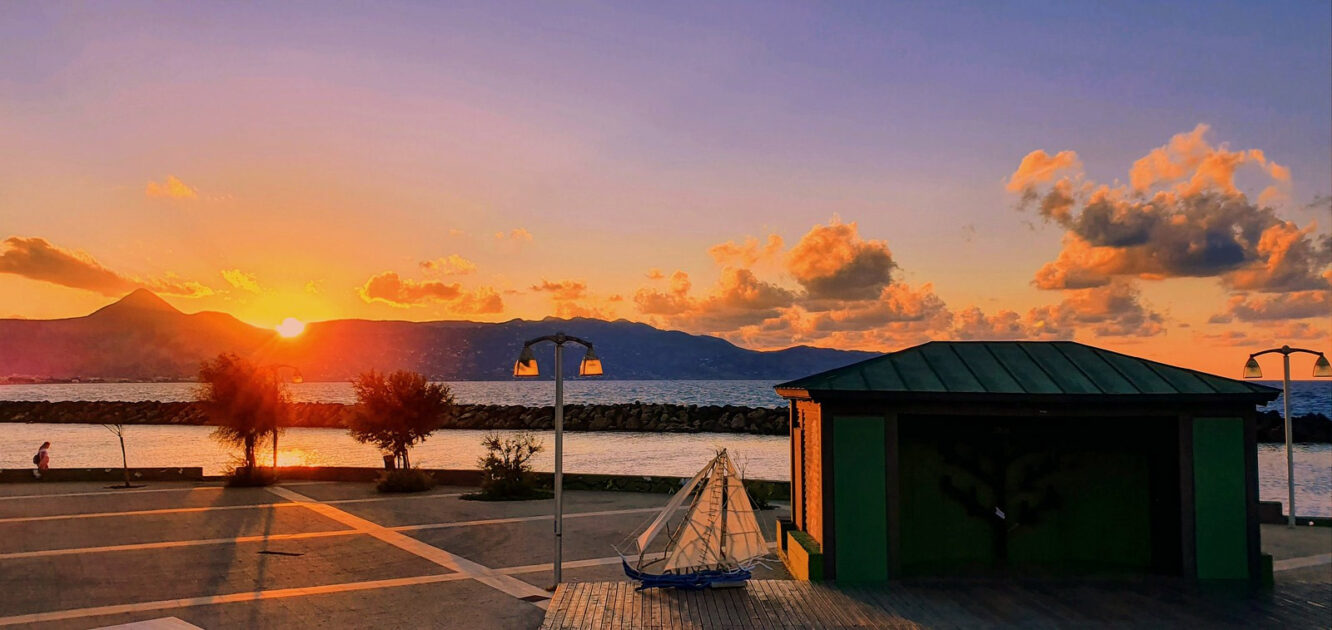
Visitors observe the flow of local life while walking on the waterfront, watching boats arrive and depart and taking in the expansive vistas of the horizon. The waterfront, with its remnants of old Venetian influence, serves as a live reminder of the city’s illustrious past while showing its present vibrancy.
The waterfront is a crucial port for trade, warfare and cross-cultural interaction. The shoreline changed over time as empires came and went, reflecting the shifting fortunes of the city and its innate resiliency. The waterfront tells a story of a city that has skillfully braided its past into its present, from its heyday as a bustling centre of maritime operations to its contemporary status as a hub of tourist and pleasure.
The number of tourists who travelled to Heraklion’s seafront is unclear because no official figures are available. The tourism industry in Crete has expanded significantly, which is expected to have an effect on tourism in Heraklion, particularly along the waterfront.
The old Venetian Harbour and the surrounding coastal lands are included in Heraklion’s waterfront, which is situated along the city’s northern boundary by the Aegean Sea. The waterfront is about 5 kilometres away from the airport. The distance from the airport is travelled in 10-15 minutes by car or cab, depending on traffic.
Some of the sights to behold on Heraklion’s waterfront include the maritime design and old buildings. The Koules Fortress commands attention due to its size and representation of historical military architecture and Venetian influence. The old Venetian Harbour, which is nearby and is primarily used by fishing boats today, provides a gorgeous environment with its colourful boats and calm waters. Tourists come across different monuments, statues and works of public art that tell stories about the city’s maritime past. The view is completed by the marina, which is populated with contemporary ships set against a historic architectural backdrop.
Children are allowed to play endlessly along the waterfront. They embark on a mini-adventure by exploring the interior of the Koules Fortress. They run around and play in the open areas while learning about the local marine life and spotting fish in the harbour’s gently lapping waves. Young people’s appetites are satisfied because of the promenade’s abundance of ice cream shops and snack stands. They learn about the pleasures of sailing and the size of the Aegean Sea by taking boat trips from the harbour.
The Waterfront in Heraklion is safe, especially throughout the day, but like in any tourist location, always exercise caution with one’s personal property. Strolling around the waterfront is free. Some sites, like the Koules Fortress, are anticipated to charge a price to enter.
Some restaurants near the waterfront in Heraklion are as follows, namely; Ippokambos and Kastella. Ippokambos offers a delicious combination of classic Cretan flavours with a contemporary twist. Diners savour delectable meals while taking in views of the Aegean Sea because of its advantageous location close to the shore.
Ippokambos is a seafood lover’s paradise, with a menu bursting with just-caught specialities from the nearby waters. The restaurant is a popular destination for both locals and visitors to take in a dinner by the water, given its laid-back ambience and proximity to the beach. The elegant, modern appearance of Kastella sets it apart from other restos, while its extensive menu fuses Mediterranean food with other cultures. Customers enjoy magnificent sea views because of the restaurant’s excellent location facing the waterfront, making their dining experience very unique.
Some hotels near the waterfront in Heraklion include the Lato Boutique Hotel, Megaron GDM Hotel and Aquila Atlantis Hotel. Lato Boutique Hotel, which has a view of the Venetian Fortress in Heraklion, offers a distinctive fusion of contemporary conveniences with Cretan customs. The Megaron GDM Hotel has an opulent atmosphere and a superb location with expansive views of the harbour and the Aegean Sea. Luxury lodgings are available at the Aquila Atlantis Hotel, which combines modern elegance with expansive views of the port.
17. Discover the Palace of Knossos
Exploring the Palace of Knossos enhances a Heraklion tour, showcasing the Minoan civilization from Crete’s Bronze Age. This vast complex offers insight into a culture from over 4,000 years ago, often dubbed Europe’s oldest city.
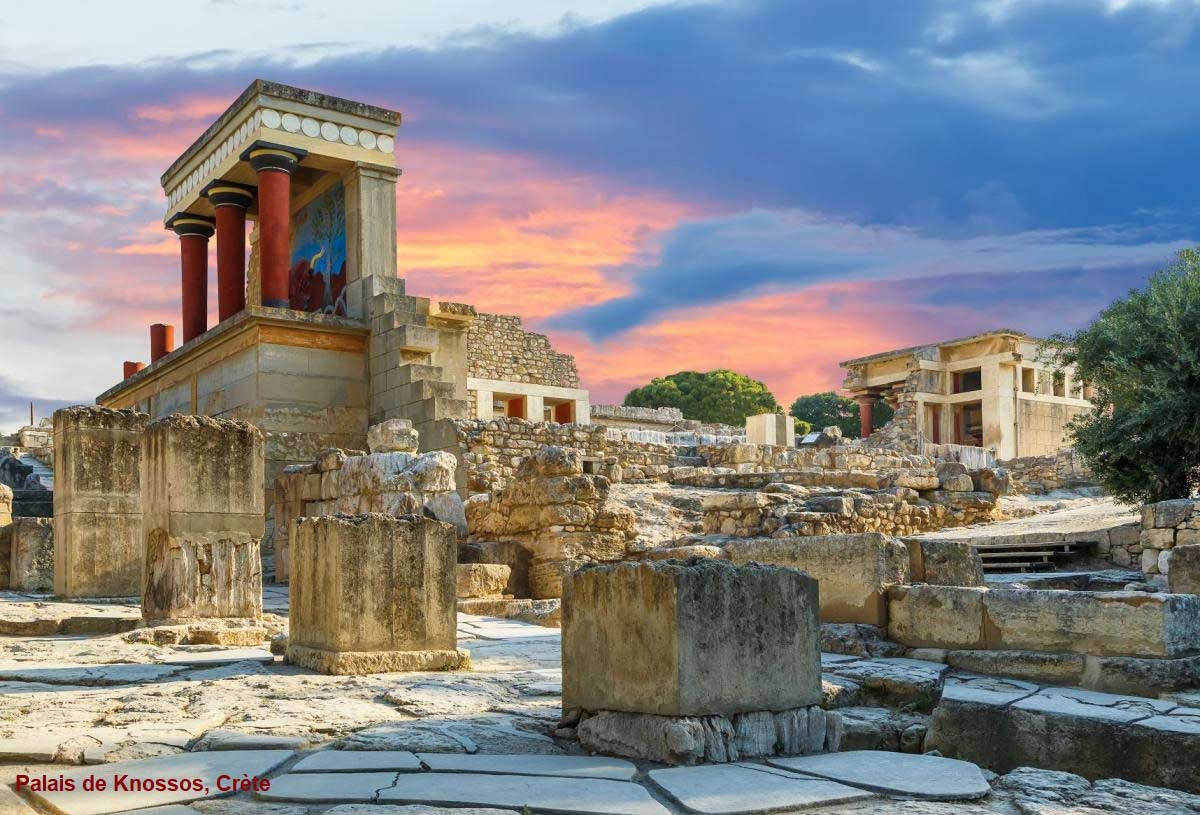
The palace’s elaborate design, which includes multi-story buildings, intricate frescoes, sophisticated plumbing systems and winding passageways, highlights the skill and ingenuity of the Minoans. The palace served as King Minos’ residence and the location of the fabled Labyrinth, where the mythological Minotaur is said to have been imprisoned, according to legend.
Knossos, the hub of Minoan civilisation, was at its height between 2000 and 1400 BC. The first palace was constructed around 2000 BC, but it was destroyed 300 years later and then larger-scale reconstructions were made. The following palace, the remains of which are seen today, rose to prominence as the centre of Minoan politics, trade and culture.
A series of environmental catastrophes and invasions circa 1380 BC resulted in its eventual demise. The history of the palace is intricately entwined with the myth of the Minotaur, a half-bull, half-man creature whose design is credited with being the source of the Labyrinth mythology.
The sights to behold in the Palace of Knossos include the Grand Staircase, which provides a view into the palace’s multi-story construction and the Throne Room, which is thought to be one of Europe’s oldest throne chambers. There are paintings in the complex, such as the “Prince of the Lilies” and “Dolphin Fresco”, standing out for their exquisite detailing and vibrant colours. The layout of the complex provides insight into the Minoan way of life with its storerooms, residential quarters and ceremonial spaces.
The Palace of Knossos serves as a portal to mythology and legends for children. Youngsters engage in treasure hunts through labyrinthine passages, hearing stories of King Minos, the Minotaur, and Theseus. Interactive guided tours tailored for children make history engaging and enjoyable. The site’s layout supports open-air activities and exploratory hikes, ensuring memorable experiences for younger visitors. While generally safe, visitors should avoid rough paths or steps. The admission fee to Knossos Palace is 15 € ($15.90, £12.90).
Restaurants near the Palace of Knossos include Pasiphae Restaurant, Minotavros, and The Little Garden. Pasiphae Restaurant offers traditional Cretan cuisine using local products, attracting visitors due to its variety and 0.2 kilometers (0.12 miles) distance from the Palace. Minotavros, named after the Minotaur of Knossos, serves classic meals with modern touches, such as moussaka and croquettes, in an ambiance reflecting regional tradition, just 0.1 kilometers (0.06 miles) from the Palace. The Little Garden provides a garden-to-table approach to Cretan cuisine in a tranquil setting, located 0.2 kilometers (0.12 miles) from the Palace.
Hotels near the Palace of Knossos include Galaxy Hotel Iraklio, Sofia Hotel, and Legacy Gastro Suites. Galaxy Hotel Iraklio offers contemporary luxury with amenities like a large pool and gourmet restaurant, located 4.0 kilometers (2.5 miles) from the Palace and providing easy access to Heraklion’s important sights. Sofia Hotel, 4.1 kilometers (2.5 miles) from Knossos Palace, offers a cozy ambiance, appealing to visitors interested in ancient history and modern Crete. Legacy Gastro Suites combine luxury accommodations with a gourmet experience celebrating Cretan tradition, situated 4.7 kilometers (2.9 miles) from Knossos Palace.
18. Discover the Loggia (Town Hall)
Visitors to Heraklion should visit the Loggia, the Town Hall, showcasing Venetian-era architectural design in Crete. The Loggia, constructed during Venetian rule, functioned as a meeting place for feudal lords and aristocracy and now serves as Heraklion’s Town Hall.
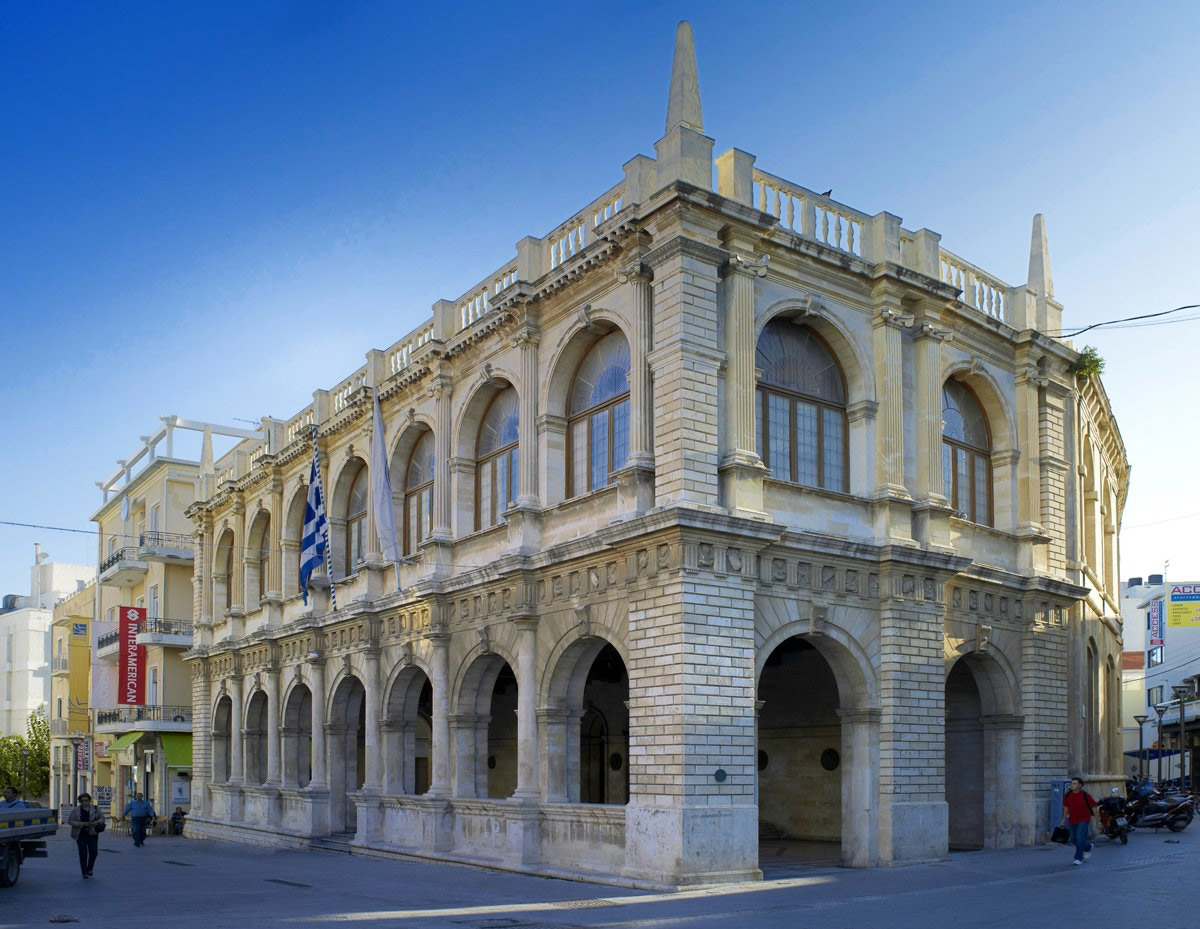
The Loggia building is renowned for its perfect proportions, elegant arches, and sturdy pillars. It served as the social and administrative center of Venetian Heraklion, where significant decisions were made and the city’s elite gathered to discuss matters of administration, business, and society.
The Loggia is one of the most beautiful specimens of Renaissance architecture on the Greek island of Crete. The edifice was designed by the renowned architect Morosini in the 16th century under Venetian domination. It experienced several alterations and reconstructions, particularly after major earthquakes while the building preserved its prominence over the ages.
The structure was utilised for a variety of functions and it was even threatened with demolition at one point after Venetian rule ended. It regained its former glory and was repurposed as Heraklion’s Town Hall in the twentieth century, after substantial repair. The Loggia’s long impact was further solidified when it was designated a UNESCO World Heritage Site.
The Loggia is located on 25th Avgoustou Street in the centre of Heraklion. The distance from the airport is roughly 5 kilometres and travel time takes approximately 10-15 minutes by vehicle or taxi, depending on traffic conditions.
Some of the sights to behold inside the cathedral include its Renaissance architecture. The internal courtyard, with its beautifully arching arches and sturdy stone columns, exemplifies great craftsmanship. Original Venetian insignia and engravings provide an insight into the past. The administrative offices on the upper floors provide panoramic views of the city’s centre square and adjacent attractions. Numerous architectural subtleties and historical artefacts around the building give light on the Loggia’s illustrious past and voyage through time.
The Loggia provides a fascinating glimpse into history for children. They are introduced to the world of Venetian lords, knights and legends through interactive guided tours. Educational workshops organised in historic buildings allow children to participate in activities such as making Venetian masks or drawing the architectural intricacies of the Loggia. There are scavenger hunts or quizzes on the Loggia and its history, which makes the experience more interesting and enjoyable for the young ones.
The Loggia (Town Hall) is safe for visitors, although as with any public facility, regular safety procedures and security regulations must be followed. The Town Hall is accessible every day and admission is free. Some areas are prohibited due to the presence of the operational Heraklion municipal hall.
Some restaurants near the Loggia (Town Hall) include Strip Grill, Ladokolla and Ouzeri Katsinas. Strip Grill is a sophisticated café that specialises in grilled delicacies, with a new twist on classic meals served in a sleek, urban atmosphere. The restaurant is closely situated to Loggia serving breakfast, lunch and dinner in Mediterranean, European and Greek cuisine.
Ladokolla embraces the spirit of Greek food, serving hearty and authentic dishes created using traditional cooking methods wrapped in baking paper or “Ladokolla” in Greek. The close proximity of the restaurant to the town hall and its rustic setting bring diners to the heart of Cretan culinary traditions. Patrons are welcome to partake in the typical Greek “ouzeri” experience at Ouzeri Katsinas, where a variety of mezedes (small foods) are combined with the renowned spirit, ouzo. The restaurant has a relaxing, seaside-inspired ambience, making it an ideal place to unwind while sampling Aegean flavours.
Here are some hotels located near the Loggia (Town Hall): GDM Megaron Historical Monument Hotel, ibis Styles Heraklion Central, and Lato Boutique Hotel.
The GDM Megaron Historical Monument Hotel offers guests a luxurious experience within a protected architectural marvel in the heart of Heraklion, just 0.22 kilometers away from the Town Hall. The hotel provides a range of amenities, including complimentary parking, a pool, a gym, and free breakfast.
The Ibis Styles Heraklion Central, featuring a modern design and high-quality amenities, offers a stylish and comfortable retreat for travelers seeking contemporary conveniences near Heraklion’s main attractions. Located approximately 0.11 kilometers from the Loggia, the hotel includes a bar, business center, currency exchange service, and more. Meanwhile, the Lato Boutique Hotel, which overlooks Heraklion’s harbor and landmarks, blends sophisticated aesthetics with traditional Cretan elements. Situated just 0.13 kilometers from the Loggia, it provides guests with a unique boutique experience, offering a pet-friendly environment, babysitting services, and air transportation.
19. Discover Heraklion’s lively open markets
Heraklion’s open markets immerse visitors in Crete’s vibrant culture and daily life. These bustling marketplaces, particularly along 1866 Street, feature stalls brimming with fresh produce, traditional crafts, spices, and local delicacies. They are not merely commercial hubs but social spaces where merchants share stories, recipes, and insights, offering tourists a glimpse into the Cretan way of life.
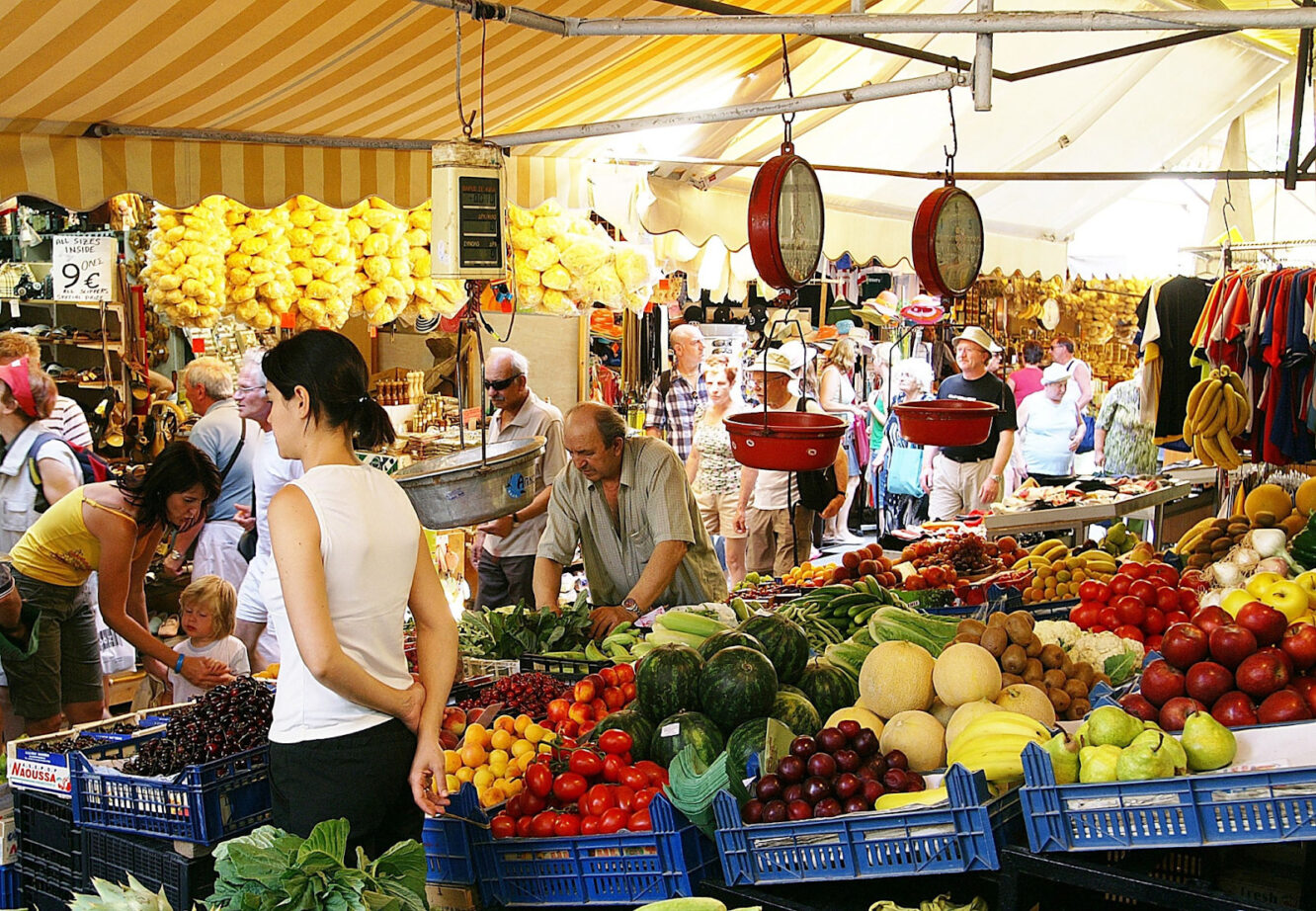
Heraklion’s history of open markets mirrors its role in Mediterranean trade. Historically vital for commerce, these markets today sell local harvests, handmade crafts, and imported goods, reflecting both tradition and modernity. Although no official data exists on tourist numbers at these markets, Crete’s booming tourism industry likely draws many visitors to this cultural experience. Located approximately 5 kilometers (3.11 miles) from the airport, the markets are a 10-15 minute drive by car or taxi.
Heraklion’s open markets present a sensory experience. Visitors encounter sun-ripened vegetables, fragrant herbs, seafood, and meats. Handcrafted jewelry, Cretan textiles, and pottery display the creativity of local artisans, while stalls offering olives, cheeses, and honey-soaked pastries provide a taste of authentic Cretan cuisine. Vendors selling antiques and trinkets add a nostalgic element. The sounds of traditional Cretan music and the aroma of freshly brewed coffee complete the lively atmosphere.
Children find the open markets both educational and entertaining. They can learn to identify various fruits and crafts, interact with artisans, or enjoy weaving and pottery demonstrations. Vendors often share folklore or tales connected to their goods, making the market a blend of storytelling and discovery. Local treats such as honey-drenched pastries and fresh fruit juices add to the experience.
Visiting Heraklion’s open markets is generally safe. However, tourists should safeguard their belongings and avoid displaying valuables. Entry to the markets is free, creating an accessible experience for all visitors.
Nearby restaurants include M Ethia, Sarantavga, and Giakoumis Taverna. M Ethia blends traditional Cretan recipes with modern culinary techniques, focusing on fresh, locally sourced ingredients. Sarantavga offers healthy meals throughout the day, catering to late-night diners and featuring a wide selection of beverages. Giakoumis Taverna specializes in rustic, hearty Cretan dishes, providing vegetarian and vegan options for lunch and dinner.
Hotels near Heraklion’s open markets include the Galaxy Iraklio Hotel, Lato Boutique Hotel, and Aquila Atlantis Hotel. The Galaxy Iraklio Hotel, 0.99 kilometers (0.62 miles) from the market, offers luxury amenities, including an outdoor pool and meeting spaces. Lato Boutique Hotel, 0.48 kilometers (0.30 miles) away, combines contemporary design with Cretan accents and organizes activities such as diving and horse riding. The Aquila Atlantis Hotel, also 0.48 kilometers (0.30 miles) from the market, provides elegant accommodations with panoramic city views, ensuring a comfortable and convenient stay.
20. Admire the Cathedral of St. Minas
Visiting the Cathedral of St. Minas enhances any trip to Heraklion. The Cathedral of St. Minas stands as one of Heraklion’s most prominent religious landmarks, embodying spiritual devotion and architectural grandeur. As one of Greece’s largest churches, it is dedicated to Saint Minas, the patron saint of Heraklion. Its imposing façade, intricate interiors, and towering dome showcase Heraklion’s rich ecclesiastical heritage and serve as a focal point of worship and reverence for the local Christian community.
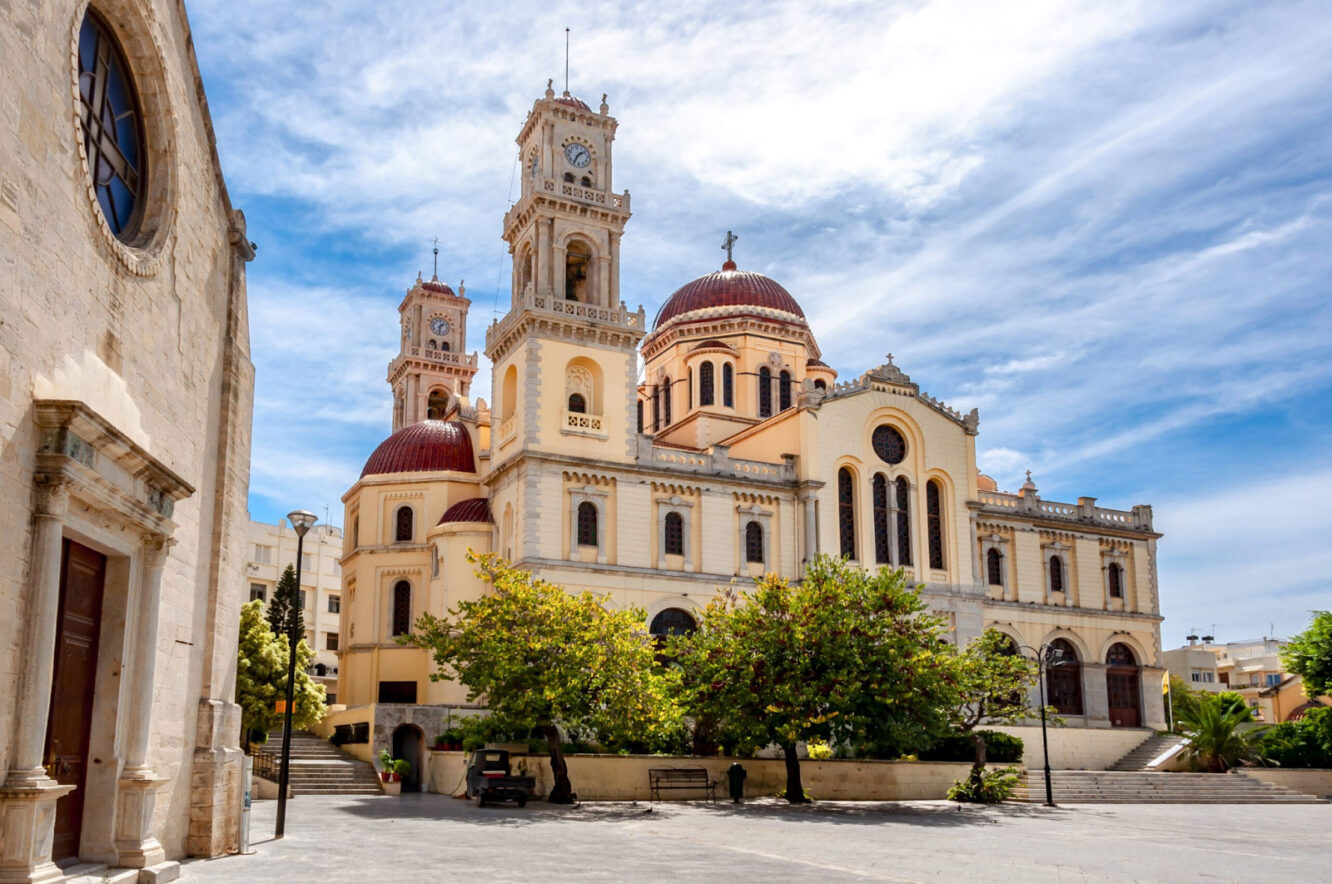
St. Minas Cathedral reflects Heraklion’s history and religious traditions. Construction began in the mid-19th century and concluded in the early 20th century. Dedicated to Saint Minas, who defended Heraklion during the 17th-century Ottoman siege, the cathedral symbolizes the city’s resilience, surviving periods of conflict and renewal.
Tourist numbers specific to St. Minas Cathedral remain undocumented. However, Crete’s growing tourism industry likely impacts visitation to Heraklion and the cathedral. Situated in Plateia Agiou Minos, the cathedral is 4-5 kilometers (2.49-3.11 miles) from the airport, with a 10-15 minute travel time by car or taxi, depending on traffic.
St. Minas Cathedral’s architecture features high ceilings adorned with biblical murals and a central dome. The intricate altar is a focal point, while each chapel holds unique religious and artistic significance. Stained glass windows cast vibrant reflections on marble floors, enhancing its spiritual ambiance. Religious icons, relics, and artifacts contribute to the cathedral’s significance.
For children, the cathedral offers educational and interactive experiences. Guided tours explain biblical murals and religious artifacts, while workshops or storytelling sessions make its history engaging and accessible.
St. Minas Cathedral is generally safe for visitors. While entry to Greek Christian cathedrals is free, donations for upkeep are customary. Visitors should remain vigilant about personal belongings, as in any public setting.
Nearby restaurants include the Cattedrale espresso bar, Bombus Street Loukoumas & Coffee, and Emigre. The Cattedrale espresso bar offers handcrafted coffee and a tranquil setting. Bombus Street Loukoumas & Coffee serves loukoumas paired with fresh coffee in a lively street-side atmosphere. Emigre blends contemporary flavors with Greek traditions, offering breakfast, lunch, and dinner options.
Hotels near St. Minas Cathedral include the Olive Green Hotel, Atrion Hotel, and Dom Boutique Hotel. The Olive Green Hotel, located 0.34 kilometers (0.21 miles) from the cathedral, emphasizes sustainability with modern amenities. The Atrion Hotel, 0.29 kilometers (0.18 miles) away, combines contemporary design with Cretan hospitality. Dom Boutique Hotel, just 0.28 kilometers (0.17 miles) from the cathedral, features elegant interiors, personalized service, free breakfast, and additional amenities.
What is Heraklion best known for?
Heraklion is best known for its historic museums, cultural sites and lovely beaches. The region is famous for its cuisine and wineries at the same time.
The ancient Minoan palace of Knossos, considered Europe’s oldest city, is central to Heraklion’s historical environment. Visitors are transported back to the Bronze Age by its elaborate frescoes, storied chambers and legends of King Minos and the Minotaur. The journey through time is complemented by the Archaeological Museum of Heraklion, which houses a large collection of Minoan artefacts, some of which date back thousands of years ago.
The city’s Old Town is a cultural melting pot, with Venetian walls, Turkish fountains and Byzantine churches intermingled among modern businesses. Heraklion is surrounded by beachfront stretches that range from quiet retreats to highly developed, expensive resorts. The turquoise seas of the Mediterranean make an ideal setting for relaxation and water sports.
Every traveller is in for a culinary adventure, from tiny tavernas serving original Cretan dishes rich in olive oil and local cheeses to fancy restaurants providing gourmet versions of these classics. The region is well-known for its wineries, with Cretan wines receiving international praise for their particular flavours derived from the island’s peculiar terroir.
What are things to consider when visiting Heraklion?
The things to consider when visiting Heraklion are the following. Take in the rich historical tapestry of the city. Key sites such as the Knossos Palace, which is related to enthralling tales of the Minotaur and the Heraklion Archaeological Museum, which houses a treasure trove of Minoan antiquities, are best experienced with the assistance of a local guide.
Keep an eye out for the ancient town’s convoluted layout, which is distinguished by Venetian architecture and fortified fortifications.
Be prepared for the heat and stay hydrated, especially when visiting outdoor attractions. Wearing comfortable shoes is recommended due to the cobblestone streets and occasionally uneven terrain though the city is pedestrian-friendly. Learning a few Greek phrases improves one’s conversations and makes the locals smile, although English is widely spoken in tourist regions. Consider hiring a car when wanting to venture outside of the city limits, while public transportation is efficient.
Is Heraklion for every age?
Yes, Heraklion is for every age. Heraklion is a place that appeals to visitors of all ages, with each group discovering elements of the city that speak to them. The city provides a dynamic atmosphere for youthful visitors with its crowded cafes, hip bars and exciting nightlife. There is a youthful vitality, particularly in the areas near the university and the more modern portions of town.
Children enjoy discovering the historic ruins of Knossos while imagining stories about Minotaurs and labyrinths. They have plenty of places to play and enjoy themselves in the city’s parks, along the seaside and in the open areas. Middle-aged tourists and families admire the city’s rich history, which is explored through its museums, historical sites and the Ancient Venetian Walls. Traditional Cretan cuisine is served in a wide variety of restaurants and taverns, making it accessible to people of all ages to experience gastronomic exploration.
Visitors over the age of 60 take leisurely strolls along the historic Venetian harbour, unwind in one of the city’s many squares or explore the city’s vibrant arts, music and theatrical scenes. The warm Cretan hospitality guarantees an enjoyable trip for senior citizens. Heraklion’s diverse charm, which fuses the ancient with the modern, ensures that it continues to be a destination that is inviting and interesting to travellers of all ages.
Is it safe to walk around Heraklion?
Yes, it is safe to walk around Heraklion. Heraklion is usually thought to be safe for nighttime and daytime walking, like many European towns. Tourists who visit the city and its vibrant locals fill the streets of Heraklion, adding to the feeling that there’s security.
Popular spots like the central market, the historic Venetian harbour and the pedestrian zones are teeming with activity during the day. The districts are visited by both locals and tourists with their cafes, stores and historical landmarks, which heightens the sense of security. Locals and visitors take strolls in the evening along the waterfront or through the major squares. The city has a thriving nightlife, with numerous eateries, pubs and cafes staying open late to keep the streets reasonably crowded.
Taking conventional measures is always advisable, just as in any metropolitan region. Stay in locations that are well-lit when going out late at night. Pay close attention to one’s possessions to prevent pickpockets in crowded areas or tourist areas. Becoming familiar with the surroundings and staying away from remote or less travelled locations is essential when one is unsure of them. Being aware of the surroundings and taking the bare minimum of safety precautions improves one’s experience, although Heraklion is safe for pedestrians.
How is the weather in Heraklion?
The weather in Heraklion is best described as a Mediterranean climate, which indicates warm, rainy winters and hot, dry summers since it is situated on the northern coast of the Greek island of Crete. Such a type of environment makes Crete a great travel destination, especially during the warmer months.
Heraklion’s summers are frequently hot and arid from the months of June to August. The average daytime temperature is around 30°C (86°F), it gets as high as 35°C (95°F) on really hot days. It rarely rains in such months, where the sun shines nearly nonstop. There are periodic blows of a cool northern wind called “meltemi” that provide relief from the heat, especially in the afternoon. The summer season attracts the most people for its ideal beach conditions and warm sea temperatures.
Temperatures begin to drop as summer gives way to fall during the months of September until November, especially in late October and early November. September continues to be warm, similar to a protracted summer, but by November, daytime highs are typically about 20°C (68°F). Rainfall starts to increase but still isn’t too much.
Heraklion’s winters from December to February are rather warm by northern European standards. The range of the daytime temperature is between 12°C to 16°C (53°F to 60°F). Cold spells cause lows of just a few degrees, particularly at night. Rainfall is at its highest during such months and while snowfall in the city is uncommon, it occasionally falls as a light dusting on the nearby mountains.
Heraklion enjoys a wonderful spring season from March to May. The winter rains revitalise the terrain and as wildflowers begin to bloom, they paint the countryside in vibrant colours. The average temperature is roughly 17°C (62°F) in March, while it gets as high as 24°C (75°F) in May. The beginning of less rain paves the stage for the coming dry summer months. Heraklion offers an enjoyable setting for most of the year due to its temperate climate, with each season bringing its own unique splendour.
When is the best time to visit Heraklion?
The best time to visit Heraklion is when the weather is relatively good, which is within the months of February up to December. Heraklion heats up throughout the summer months, notably from June to September, which are the warmest. The temperature is accompanied by dry weather throughout the months of June, July and August, making such months perfect for outdoor activities and exploration. August emerges as the premier month for beachgoers and swimmers looking to enjoy the Mediterranean’s soothing waters, given the high temperatures and enticing warmth of the sea.
Cooler temperatures accompany the arrival of winter. January and February are the coldest months, necessitating the need for warmer clothing when heading outside. Heraklion does not receive much rain throughout the year except for January and December, which have the highest precipitation amounts ever recorded.
How many days should visitors spend in Heraklion?
Visitors must spend 2-3 days in Heraklion to make their trip worthwhile. A complete tour of Heraklion’s key attractions, which include the Archaeological Museum, Knossos Palace, the old city walls and several historical churches and squares is normally covered within two to three days. Visitors immerse themselves in the city’s rich history, experience its vibrant local markets and waterfront and savour Cretan cuisine at local tavernas during such a time period. An extra day or two is going to be advantageous for people interested in day visits to neighbouring sites such as the Palace of Phaestos or Malia.
What are the nearby Restaurants in Heraklion?
There are a lot of nearby restaurants in Heraklion including Peskesi, Ippokambos, Herbs Garden, Erganos and Kouzeineri.
Crete’s city, Heraklion, has a diversified food scene. Peskesi, in the city centre, is a favourite for its traditional Cretan meals that emphasise local ingredients. Seafood enthusiasts must go to Ippokambos restaurant in the old harbour, which is famous for its fresh daily catches and spectacular views. The rooftop setting and Mediterranean menu of “Herbs’ Garden ” set itself apart from other restos while “Erganos” serves traditional Cretan dishes in a comfortable setting.
Kouzeineri restaurant at the heart of Heraklion city combines American cuisine with a modern twist. Checking working hours, especially during holiday seasons is always a great idea in guaranteeing that tourists obtain a seat in such famous spots.
What is the average cost of a meal in Heraklion, Greece?
The average cost of a meal in Heraklion, Greece is €52 per day. Meals in Heraklion, Greece, range in price based on the type of establishment and its location. An average meal in Heraklion costs around €21 per individual. A three-course meal in a mid-range restaurant is expected to cost a little more than simple meals between €25 and €40 per person. Seafood meals are popular and are expected to be pricey given the coastal location, while fast food or gyros stands provide even cheaper options. Check recent reviews or local sources for the most up-to-date pricing.
How much money should tourists bring when visiting Heraklion?
Tourists must bring ample money when visiting Heraklion. The average total expenditure of an average tourist in Heraklion per day for one person amounts to €158. The average total expenses for one person in a day are multiplied to the number of days they stay in the City. For example, visitors who choose to explore Heraklion in 3 days need to have €474 in their pocket. Tourists who stay for seven days or one week must have a total of €1,295 on hand.
The average hotel room rate in Heraklion for a couple is €161. A one-week trip to Heraklion for two individuals therefore costs €2,208 on average. It is a good idea to bring extra cash for unforeseen expenses. Many establishments take credit cards, so having both cash and a credit card is advantageous.
Is Heraklion an expensive place to visit?
Yes, Heraklion is an expensive place to visit. Heraklion receives a regular stream of tourists being the capital of Crete and a major gateway to the island, which affects costs, particularly during the busiest travel season.
Heraklion, like many other tourist sites, offers a variety of price points to suit all budgets. Heraklion offers a range of lodging options, from five-star hotels to more affordable alternatives. People who choose to eat at neighbourhood tavernas and cafes, where traditional Cretan food is available are expected to pay modest costs. Upmarket restaurants are more expensive, particularly those in desirable areas or with menus that cater to tourists.
The entrance costs for attractions like the Knossos archaeological site and the Heraklion Archaeological Museum are comparable to those for significant historical sites in other parts of Greece. Deciding to rent a car for mobility add-up expenditures such as fuel, insurance and parking. Shopping in the central market and neighbourhood stores is a joyful experience with so many reasonably priced things available. There are shops that overcharge customers just like in any popular tourist destination.
Where to rent a Car in Heraklion?
Cars in Heraklion are rented from several outlets. Renting a car in Heraklion, Crete’s capital, is a practical alternative for people who want to explore the island at their own pace. The city has a plethora of automobile rental firms, both foreign and domestic. Many guests prefer to rent directly from Heraklion International Airport or Nikos Kazantzakis, where recognised names such as Rental Center Crete, Justrentals, Hertz, Avis and Europcar have offices, ensuring a smooth transition from flight to drive.
Some local rental firms, such as “Rental Center Crete” and “Justrentals”, are known for their competitive rates and customised service in the heart of the city and its surrounding areas. Platforms, brokers and aggregate alternatives and provide an overview of available automobiles in Heraklion for individuals who favour online convenience of booking and a diverse vehicle selection.
Make sure to read the rental agreement thoroughly including the mileage restrictions, fuel rules and required insurance regardless of one’s choice. Make an early reservation to ensure the greatest rates and car selection during peak season.
How much is the Car Rental in Heraklion?
Car rental in Heraklion varies depending on the type of car used, the location where the car is rented and the season when the car is borrowed. The average amount needed to rent a vehicle in Heraklion is €116.64 per day, according to TripAdvisor. Daily rates for a basic budget automobile range from about €20 to €30 during the off-season. The costs are expected to increase from €40 to €70 or more per day when tourism is at its peak during the summer months, especially for luxurious or larger vehicles.
The most popular rental car type in Heraklion is SUV while the cheapest rental car in the region is the Toyota Aygo which is €19.29 as offered by Rental Center Crete. Along Rental Center Crete, Hertz, Avis and Europcar are car rental businesses that serve Heraklion.
Booking ahead of time is always preferable to get the best rates. Insurance, fuel and any optional features such as GPS or kid seats incur additional charges. Speak with Heraklion car rental businesses directly or compare prices on internet booking sites for the most up-to-date pricing.
Is a Driver’s Licence Required to Rent a Car in Heraklion?
Yes, a driver’s licence is required to rent a car in Heraklion. The national driver’s licence is typically sufficient if a person is from a nation that is a member of the European Union. The International Driving Permit (IDP), which is suggested for people from outside the EU, must be in addition to one’s national driving licence.
An IDP is a multilingual translation of the licence that is accepted all around the world. An IDP guarantees that, regardless of the original language of the licence, automobile rental companies and local authorities readily understand it. The minimum age requirement, which is often 21 or 23 and the condition that the driver has had their licence for at least a year are additional requirements that automobile rental firms impose. Young drivers who are under the legal driving age are subject to additional fees.
A person must have both a national driving licence and an IDP with them when renting and driving a car in Crete and Heraklion. They must present such documents when stopped by local law enforcement. Make sure all relevant papers are brought to the trip and check the specific criteria of the Heraklion car rental provider before departing to avoid any issues.
Does Driving in Heraklion Require Car Insurance?
Yes, driving in Heraklion requires car insurance. Heraklion requires drivers to have auto insurance same as the rest of the locations in Greece. All motor vehicles operating on Greek highways are required to carry third-party liability insurance at the very least. The fundamental insurance policy ensures that whatever damage is caused to other people or property in the event of an accident is compensated for. Third-party insurance is often included in the rental contract when renting a car in Heraklion. Travellers must always carefully review the insurance’s terms to understand the breadth of the coverage.
Third-party insurance does not protect against harm to the rental car itself although it is required. A lot of tourists decide to purchase supplementary comprehensive or collision damage waiver (CDW) insurance, either through the rental business or using the perks of their credit card. It is to enjoy better coverage and to give them peace of mind when navigating Heraklion’s busy streets and winding highways. Having appropriate car insurance is essential when visiting Crete considering the variety of road conditions and possibilities for small collisions or accidents.
How far is Heraklion from the nearest airport?
Heraklion is 3 km away from the nearest airport, the Heraklion International Airport. The establishment bears the name of the famous Greek novelist, Nikos Kazantzakis and is located in Heraklion’s main city. The airport serves as the principal cross-country and domestic gateway to Crete. The travel from the airport to the city takes roughly 6 minutes via urban buses under typical traffic circumstances. There are other transportation choices to reach the airport such as taxis and rental cars, with different time durations. The airport’s closeness guarantees that guests spend a short time travelling.
What are the nearby Hotels in Heraklion?
There are several nearby hotels in Heraklion including the Galaxy Iraklio Hotel, Lato Boutique Hotel, Olive Green Hotel and Capsis Astoria Heraklion. The Atrion Hotel and GDM Megaron Hotel are some other leading hotels in Heraklion.
Heraklion, Crete’s busy city, has a wide range of hotels to suit all tastes and budgets. The “Galaxy Iraklio Hotel”, located in the centre of the city, provides upmarket amenities and a pleasant stay. The “Lato Boutique Hotel” is located near the historic harbour and offers stunning views of the sea and the Venetian fortification to visitors looking for waterfront views. The “Olive Green Hotel” is an environmentally friendly choice that combines contemporary with sustainable methods, appealing to the environmentally aware guest.
Capsis Astoria Heraklion Hotel stands out for its modern style and central position, which makes city travel simple. The “Atrion Hotel” offers a peaceful haven just a stone’s throw from the bustling city centre. The GDM Megaron, Historical Monument Hotel provides an elegant stay in a historic property that blends the beauty of yesteryear with modern conveniences. Booking ahead of time, especially during high seasons is advantageous to ensure availability in such popular spots.
Is Heraklion Crete worth visiting?
Yes. Heraklion Crete is worth visiting. Heraklion, the thriving capital of Crete, is undoubtedly a location well worth visiting because it embodies a fascinating fusion of the past and the present.
The substantial historical legacy of Heraklion is located at the city’s core. The city provides a direct entryway to the mysterious Minoan civilisation, through the famed archaeological site of Knossos. The ancient palace complex takes visitors to the era of Europe’s first known civilisation with its beautiful murals and architectural wonders.
Byzantine churches that date back to the early Cretan era and imposing Venetian walls and strongholds that indicate a time when Heraklion served as an important marine outpost dot the landscape of the city. Tales of naval engagements and trade resonate throughout the ancient Venetian harbour, where the Koules Fortress stands guard.
Heraklion’s bustling modern life stands in contrast to its rich heritage. The central market of the city is humming with bustle and sells everything from artisanal products to aromatic Cretan herbs. Local tavernas and eateries offer delectable cuisine, presenting customary dishes that highlight the renowned Mediterranean diet and are enhanced by the world-famous Cretan olive oil. Heraklion’s nightlife exemplifies the city’s contemporary and energetic character, with its diverse selection of bars and clubs.
The accessible starting point for exploring Crete’s various landscapes is Heraklion. Travellers easily reach the untamed mountains in the west and the serene coastlines in the east because of its strategic location and proximity to some of the island’s most beautiful beaches.
Last updated on January 5th, 2025








